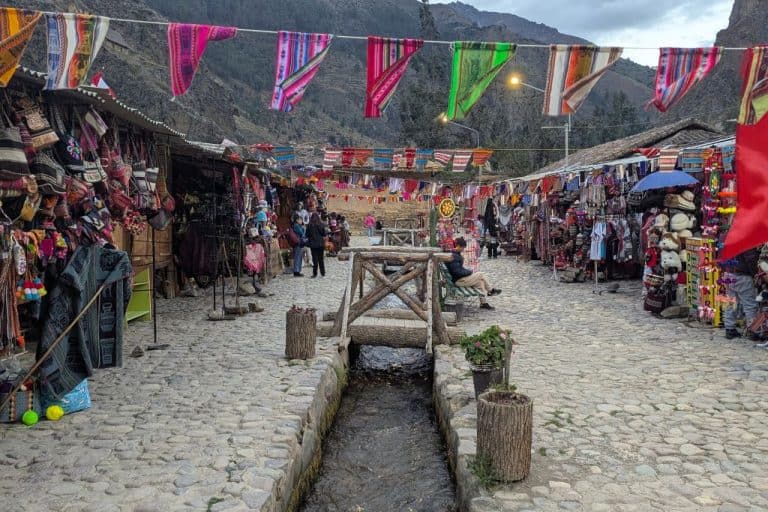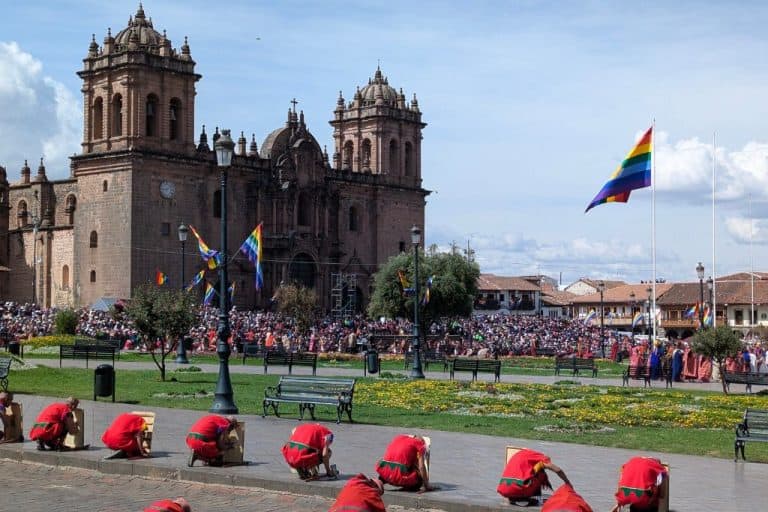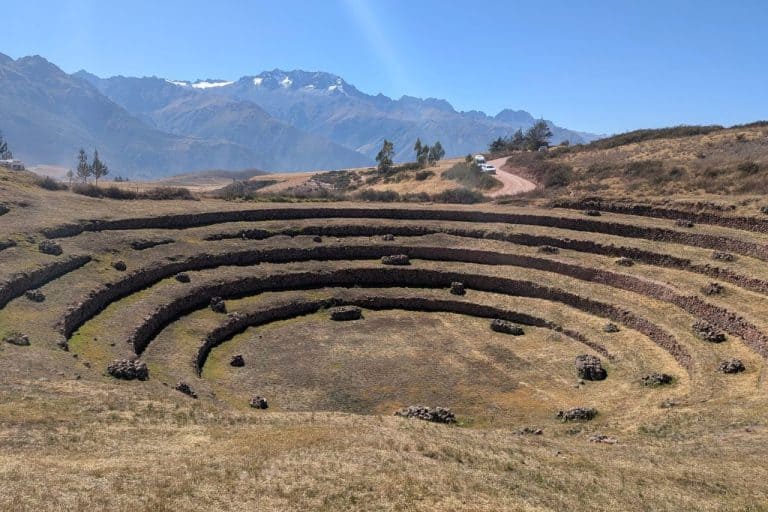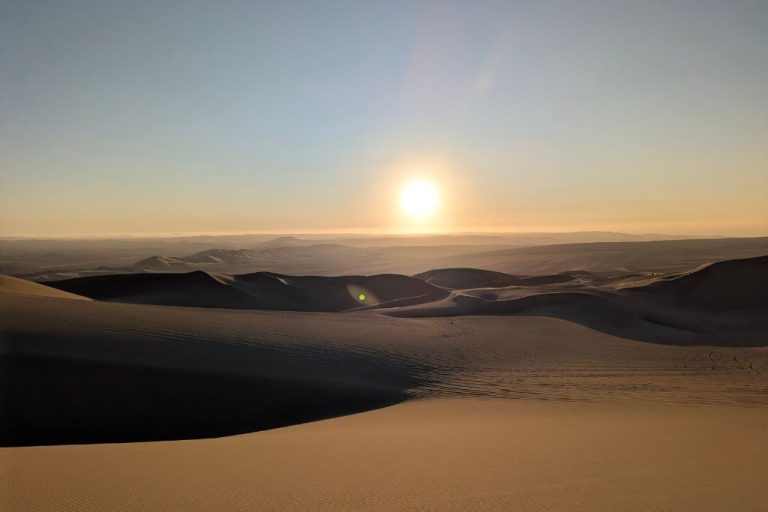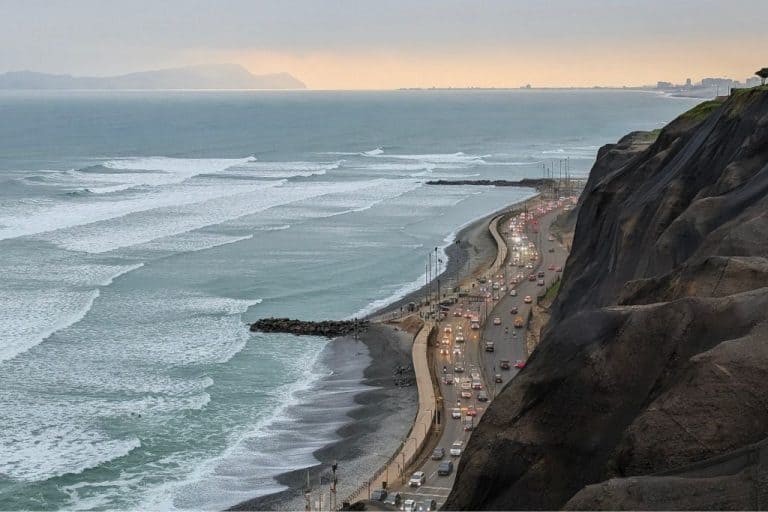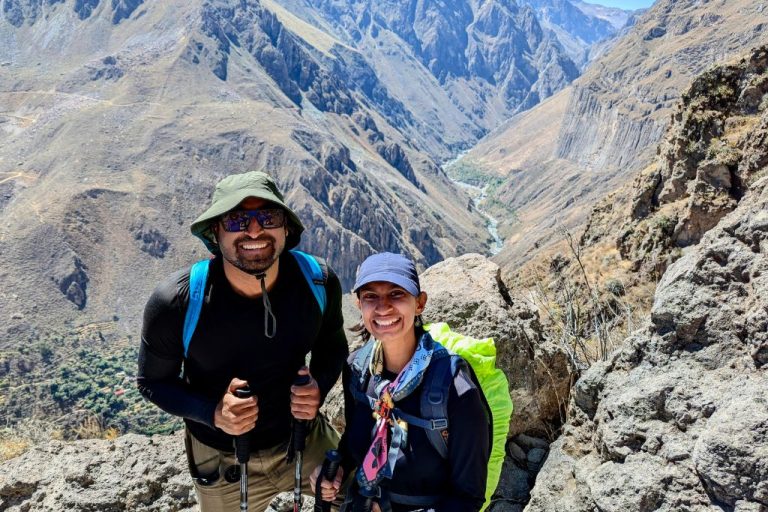The Ultimate 5D/4N Inca Trail Trek Itinerary & Guide
Stepping onto the Inca Trail in Peru is like walking back in time, a 42-kilometre (26-mile) stone-paved path through the Andes that leads to the legendary archaeological gem, Machu Picchu. Most trekkers complete this journey in 4 days, but we opted for a 5-day, 4-night itinerary for a richer, more relaxed experience. This extended trek follows the same classic route but at a slower pace, allowing us to fully absorb the wonders of the cloud forests, high passes, and Inca ruins along the way. And what an adventure it was! And we want to share this ultimate 5D/4N Inca Trail Trek Guide with you!
Over five days, we crossed rugged mountain passes shrouded in mist, explored stone ruins perched on precipices, and camped under a blanket of stars. The extra day gave us time to catch our breath (literally, at high altitude!) and soak in sights that hurried trekkers might rush past. We embarked on this journey with Alpaca Expeditions, a local outfitter known for its excellent guides and “Green Machine” team of porters. From start to finish, their crew made sure we were safe, well-fed, and comfortable – turning a tough trek into an enjoyable and unforgettable experience.
In this blog-style travelogue, I’ll recount our 5D/4N Inca Trail adventure day by day, share some personal memories (and tasty meals), shine a spotlight on the amazing Day 3 campsite, compare the 5-day vs 4-day routes, and offer tips for anyone dreaming of this trek. Lace up your boots and vamos – the Inca Trail awaits!
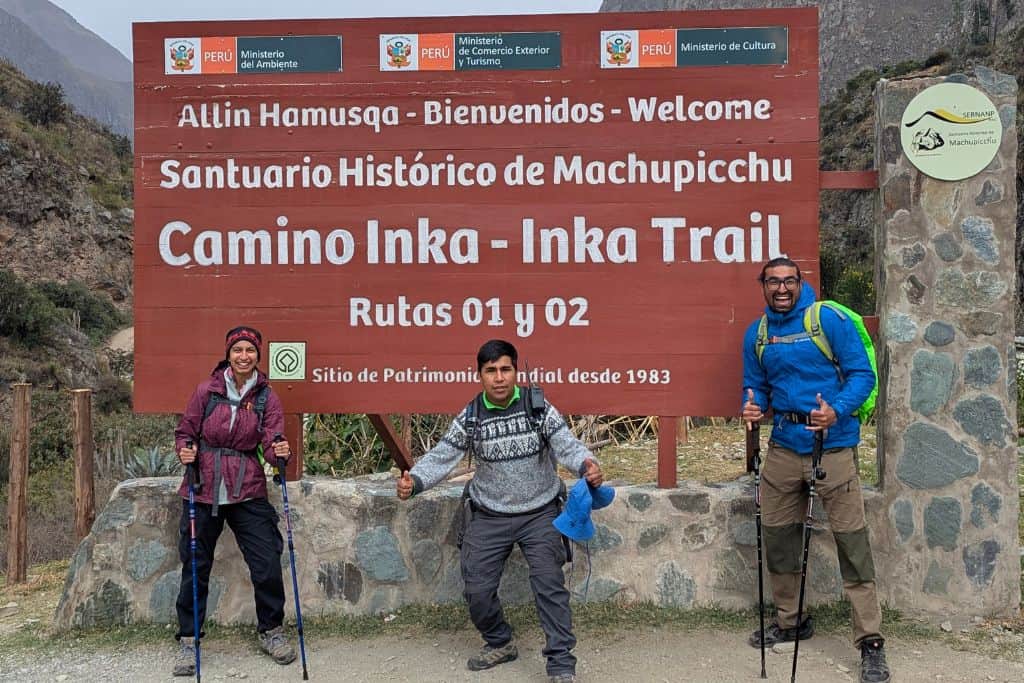
Tip: If you’re planning your own Inca Trail trek, consider arriving in Cusco a few days early to acclimatize to the 11,000+ ft elevation. Even with our extra day on the trail, the thin air made the climbs challenging, so those extra days in Cusco were a lifesaver for us.
Complete Packing List: Check out our complete packing list for the Inca Trail HERE
Day 1: Cusco to KM 82 – Starting the Adventure
Route: Cusco → Ollantaytambo → Km 82 (Piscacucho) → Wayllabamba
Distance: ~12 km | Terrain: Easy to moderate (mostly gentle uphill)
Meals: Trailhead breakfast | Trail lunch with scenic views | Camp dinner
Our journey began before dawn in Cusco. By 5:00 a.m., we were sleepily piling into Alpaca’s van, excitement outweighing the early hour. As we drove out of Cusco, the sky lightened to reveal the rolling hills of the Sacred Valley. We stopped in the picturesque town of Ollantaytambo, the traditional gateway to the Inca Trail, for a quick stretch and last-minute supplies. Ollantaytambo’s cobbled streets and Inca terraced ruins were a charming sendoff, but our real starting point lay further down the road at Km 82, also known as Piscacucho.
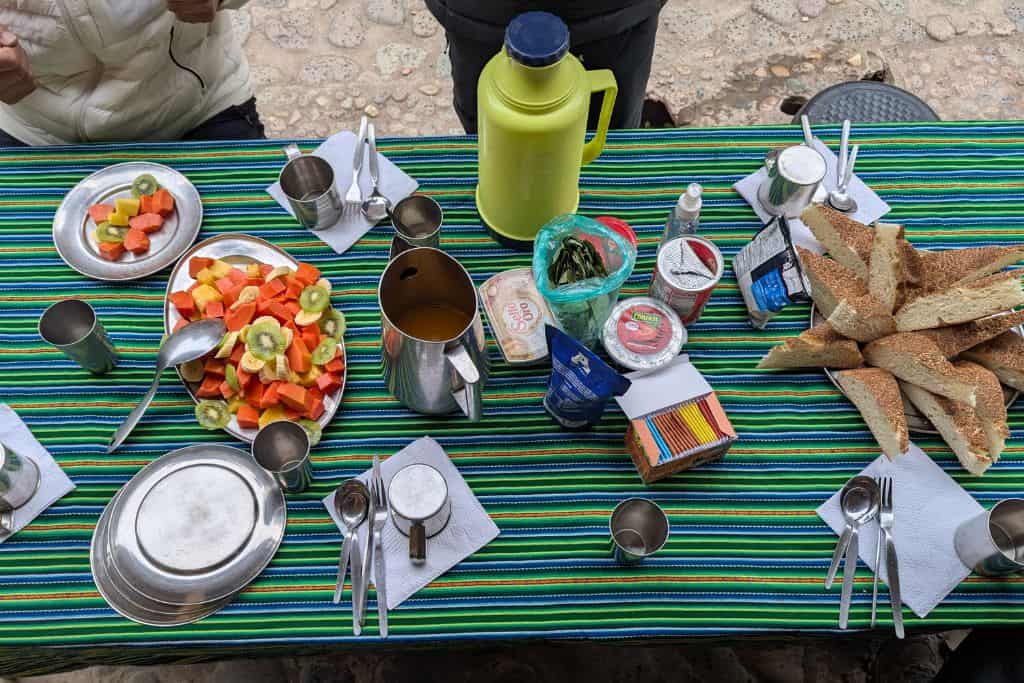
At Km 82, we met the rest of our trail crew – the cook and the team of porters who would carry tents, food, and gear. They were easy to spot in their bright green uniforms (Alpaca Expeditions’ trademark colour). While we showed our permits at the trail checkpoint and got passport stamps, our chef was busy whipping up a hot breakfast right at the trailhead. We fueled up on omelettes, toast, and hot coca tea, eating at a picnic table with the Urubamba River rushing by. Butterflies of excitement (and maybe nerves) fluttered in my stomach – after months of anticipation, we were about to walk to Machu Picchu!
Finally, we started trekking. The first hours were a gentle introduction, winding along the left bank of the Urubamba River on relatively flat terrain. The morning air was crisp and the views already stunning, verdant mountains on either side, farmers tending to potato and corn fields, and cactus lining the path. Our guide stopped to point out vibrant wild orchids and tiny hummingbirds flitting among the trees (the trail’s biodiversity was immediately apparent). We took it slow, allowing our bodies to ease into the hike and adjusting to the packs on our backs. I remember feeling pure joy at each turn of the path, every view was better than the last, and we were finally doing this trek that we had dreamed about for so long.
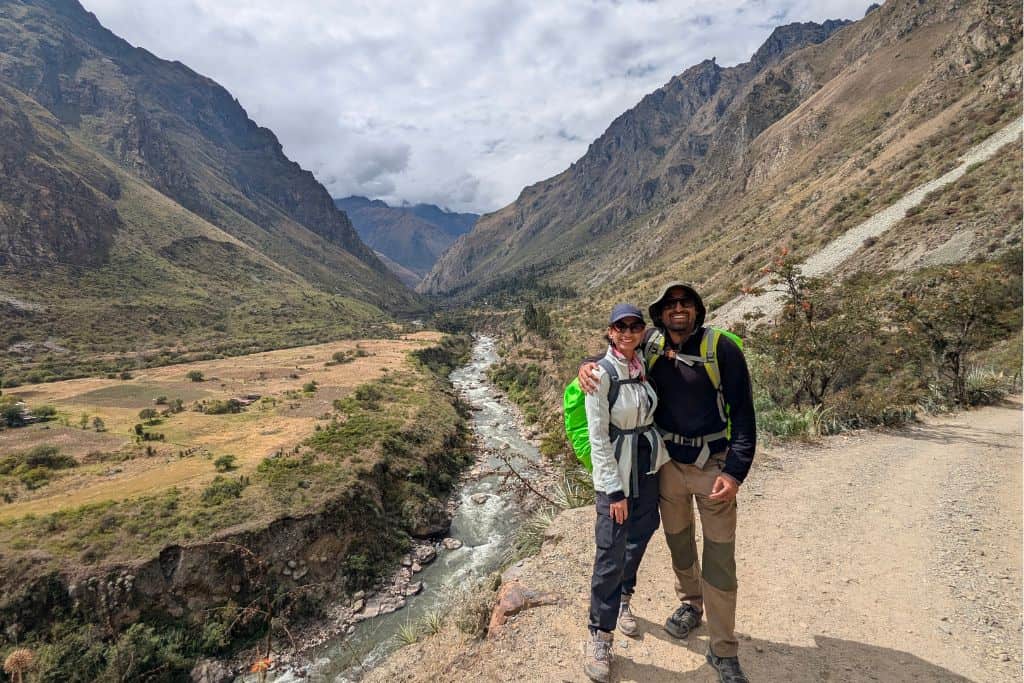
After a couple of hours, we reached our first Inca ruin: Llactapata (also called Patallacta). The trail ascended to a lookout point where suddenly this ancient site came into view below us. Terraces upon terraces of stone coursed along the valley, with foundation outlines of what were once storehouses and dwellings. The scale of Llactapata impressed me, it was like a teaser for Machu Picchu. We snapped photos while our guide Victor shared the site’s history as a farming and checkpoint town that supplied Machu Picchu. From this vantage, we could see the ruin’s strategic perch overlooking the river confluence; it’s easy to imagine Inca messengers pausing here on their sacred road.
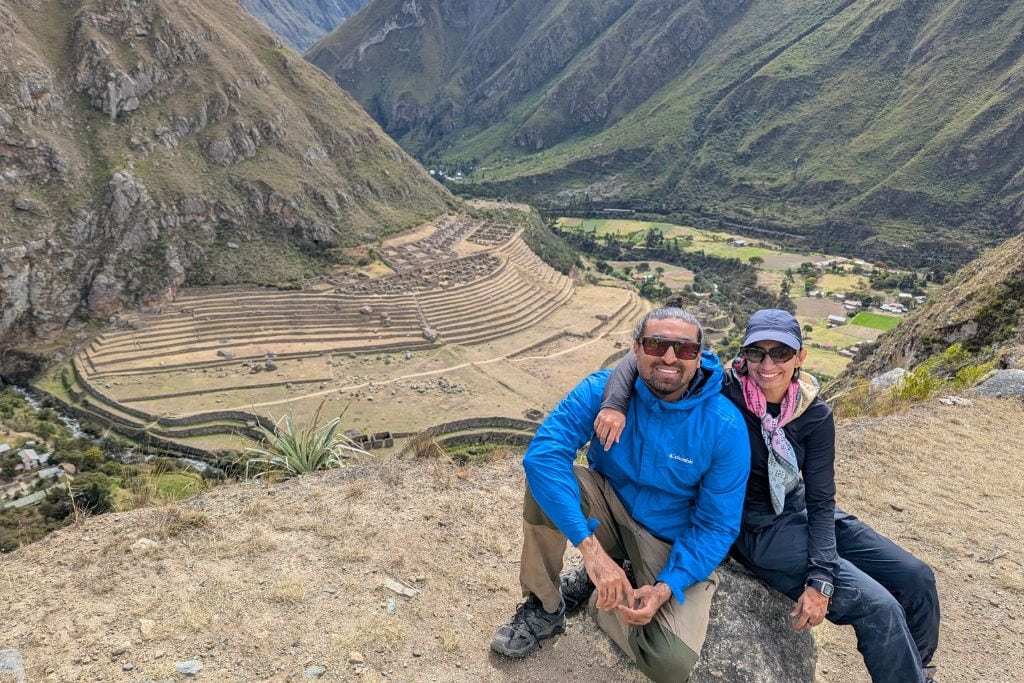
We descended from the viewpoint into the canyon for lunch, with Llactapata’s terraces still in sight. To our amazement, the porters had raced ahead and set up a dining tent complete with table, chairs, and even a tablecloth. Lunch was a buffet of Peruvian dishes: quinoa soup, trout stir-fry, rice and vegetables, and hot tea. It was our first taste of the trail’s famous food (tour companies are known for their incredible camp meals), and it did not disappoint. Eating such a feast in the middle of the Andes felt slightly surreal, was I trekking or at a restaurant? Little did we know this was just the beginning of the culinary delights. Re-energized (and a bit drowsy from the full belly), we continued hiking after a nice rest.
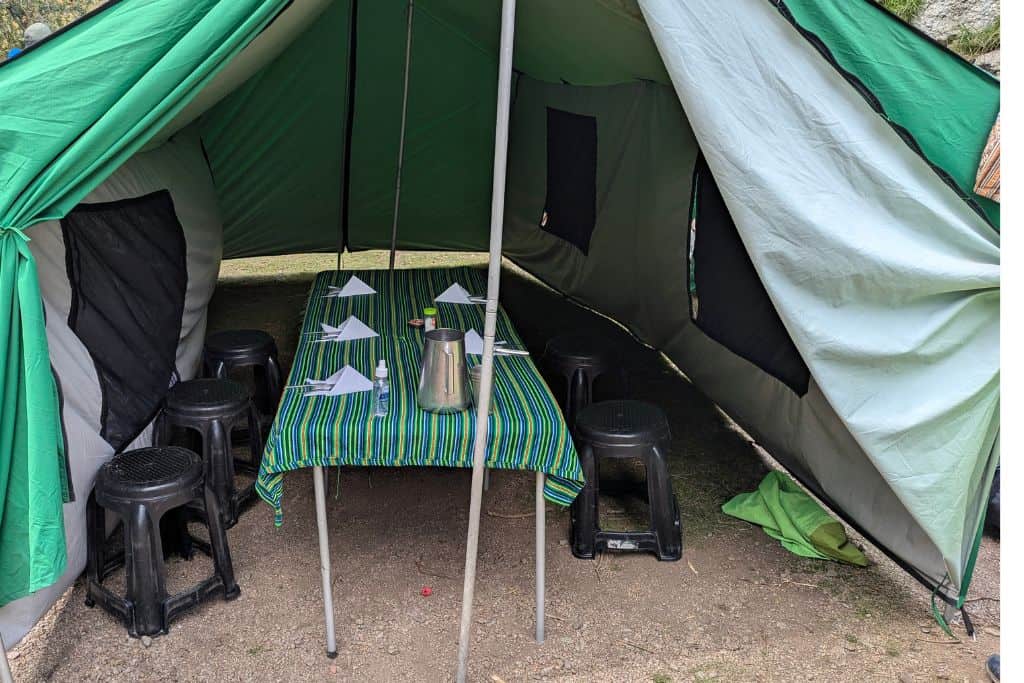
The trail after lunch undulated through a river valley and small settlements. We passed by a few traditional houses where local families sold water and snacks – a good chance to grab an Inca Cola or a packet of coca leaves for the upcoming climbs. As the afternoon sun dipped, the route became a steadier uphill. We reached Wayllabamba (2,974 m) just before dusk, where our tents were already set up for us. This would be home for Night 1.
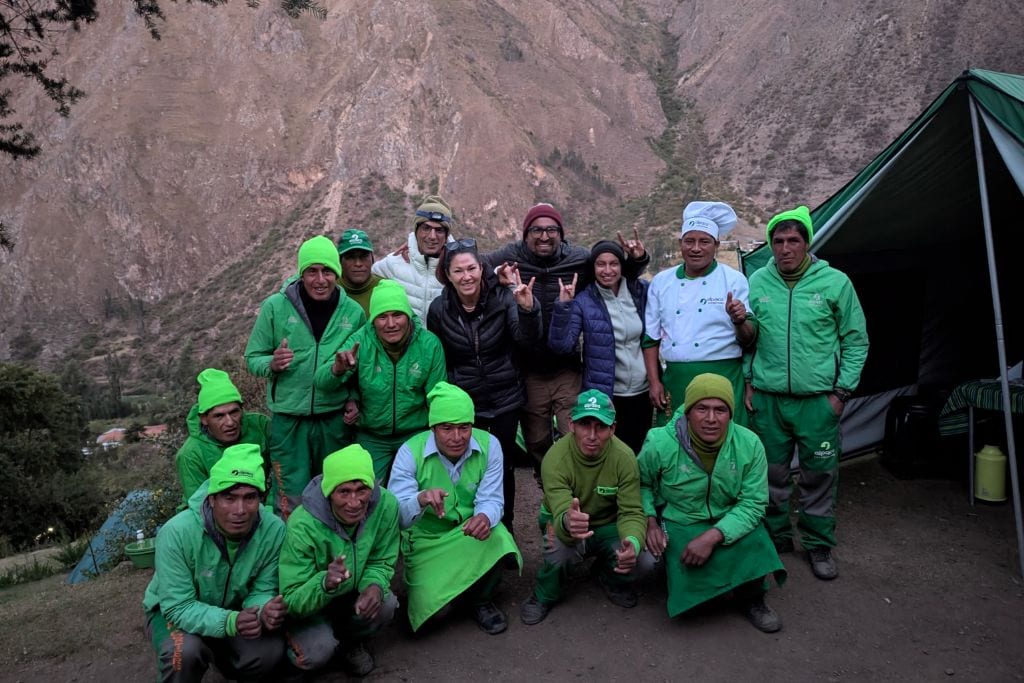
At camp, the crew greeted us with warm bowls of water to wash our dusty faces and a welcome “happy hour” snack. We crowded into the dining tent for afternoon tea – they served hot cocoa and freshly popped popcorn (a trekking tradition in Peru) and even some bread with jam. As we relaxed, our guide introduced each of the porters and the cook. We learned their names, a bit about their families, and the regions they come from. It was heartwarming to see the pride in their eyes as we applauded their hard work; these were the unsung heroes who make the trek possible, carrying heavy loads up the trail so that we hikers can walk with lighter packs. Dinner that night was elaborate: we devoured pumpkin soup, a savory lomo saltado (stir-fried beef with tomatoes and onions) served with rice, and a dessert of warm pineapple fritters. “How on earth did they cook all this on a mountain?” we marveled. As we would repeatedly find, Alpaca’s trail chefs are magicians, conjuring up gourmet meals from a tiny tent kitchen.
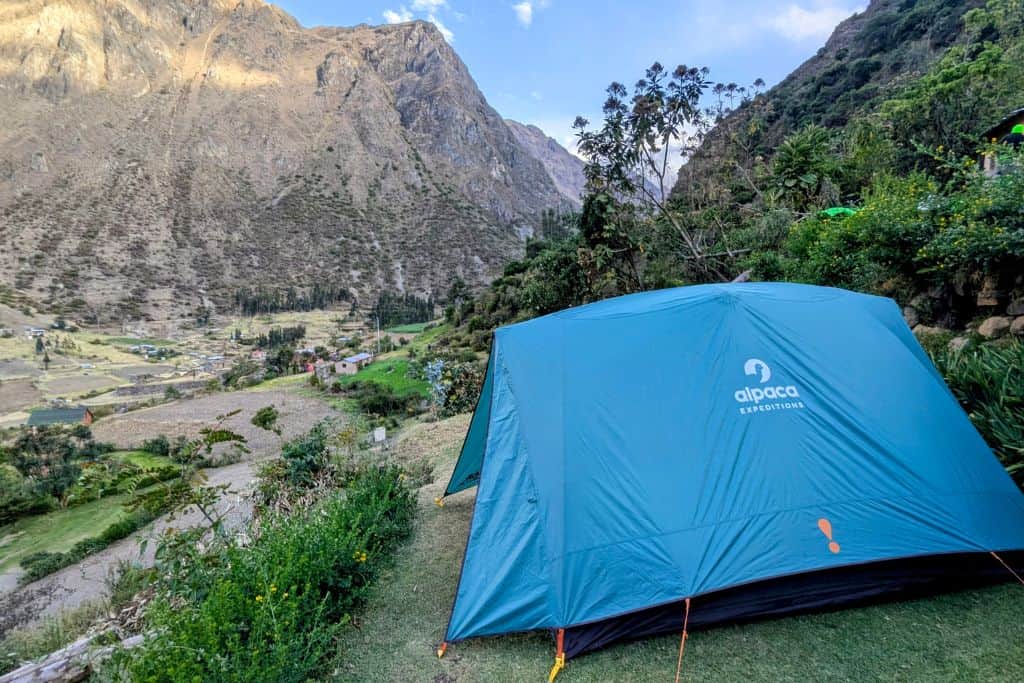
By 7:45 p.m., I was snug in my tent, bone-tired but happy. The first day’s gentle hike was a good warm-up, but tomorrow we’d face the infamous Dead Woman’s Pass, the toughest part of the trail. Lying in my sleeping bag, I listened to the sounds of the Andes at night, a distant rush of a creek, the whisper of the wind. The air at this elevation had a chill, but I felt cozy after our hearty meal. Before drifting off, I peeked outside. Above, a million stars glittered in the pitch-black sky, the Milky Way arcing right over our campsite. If this was just Day 1, I thought, what incredible experiences would the next days bring?
Memorable Moment: Clinking mugs of hot cocoa with my partner at our first camp, under a sky full of stars. We were only one day in, and already the Inca Trail’s magic was palpable
Day 2: Climbing Dead Woman’s Pass – The Trail’s Toughest Challenge
Route: Wayllabamba – Llulluchapampa – Dead Woman’s Pass – Pacaymayo camp
Terrain: Challenging – a steep ascent from ~3,000 m to 4,215 m, then a steep downhill (approx. 10 km total)
Meals: Breakfast with a view; lunch in a mountain valley; much-deserved dinner at camp
Sunrise brought a golden glow to the Andean peaks, and our gentle wake-up call came at 5:30 a.m. as a porter tapped on our tent, offering hot coca tea. (What luxury to sip a warm drink in your sleeping bag!) We emerged to crisp morning air and the sight of steam rising from the breakfast tent. After washing up with bowls of warm water, we fueled up on a high-energy breakfast: oatmeal, pancakes, and coca-leaf tea – all intended to prep us for the big climb ahead.
Over breakfast, our guide gave a pep talk about the challenge of the day: Warmiwañusqa Pass, better known as Dead Woman’s Pass, looming at 4,215 m (13,828 ft). This is the highest point of the Inca Trail and notorious for its lung-busting ascent. He reassured us that we had all day to do it at our own pace – “slow and steady”. The name Dead Woman’s Pass sounds ominous, but we learned it’s not due to any tragic story. Rather, from the valley below, the ridgeline’s silhouette resembles a woman lying on her back, as if a “sleeping beauty” were part of the mountain. Knowing this made the name feel a bit less intimidating, though as I tightened my boot laces I still felt butterflies.
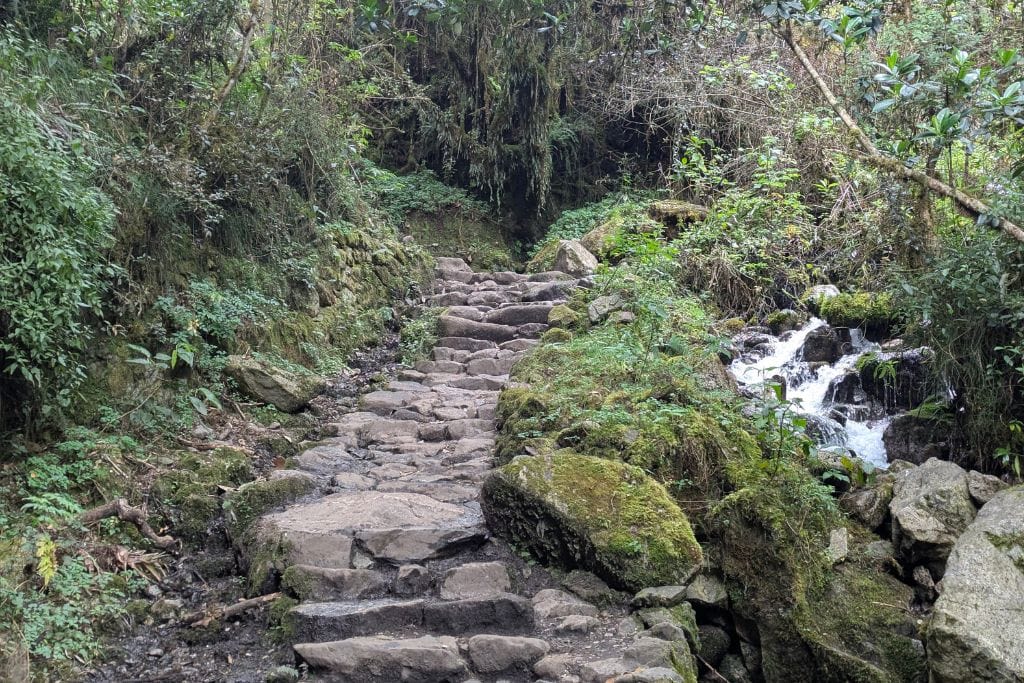
We hit the trail around 7:00 a.m. The first segment climbed gradually through cloud forest, a shaded path next to a river. Tall trees draped in moss and bromeliads flanked the trail, providing welcome shade. The sound of flowing water and birdsong put us in a peaceful mindset. After about an hour, the real ascent began – a seemingly endless series of ancient stone steps snaking up the mountain. This is where the group naturally spread out, each person finding their rhythm. Our guide stayed with the slower pace folks (which often included me), but we regrouped at rest points. Breathing became harder as we gained altitude; the air thinned and every few steps I’d pause to gulp in oxygen. I kept chewing coca leaves (an age-old remedy for altitude) and encouraged myself: one step at a time.
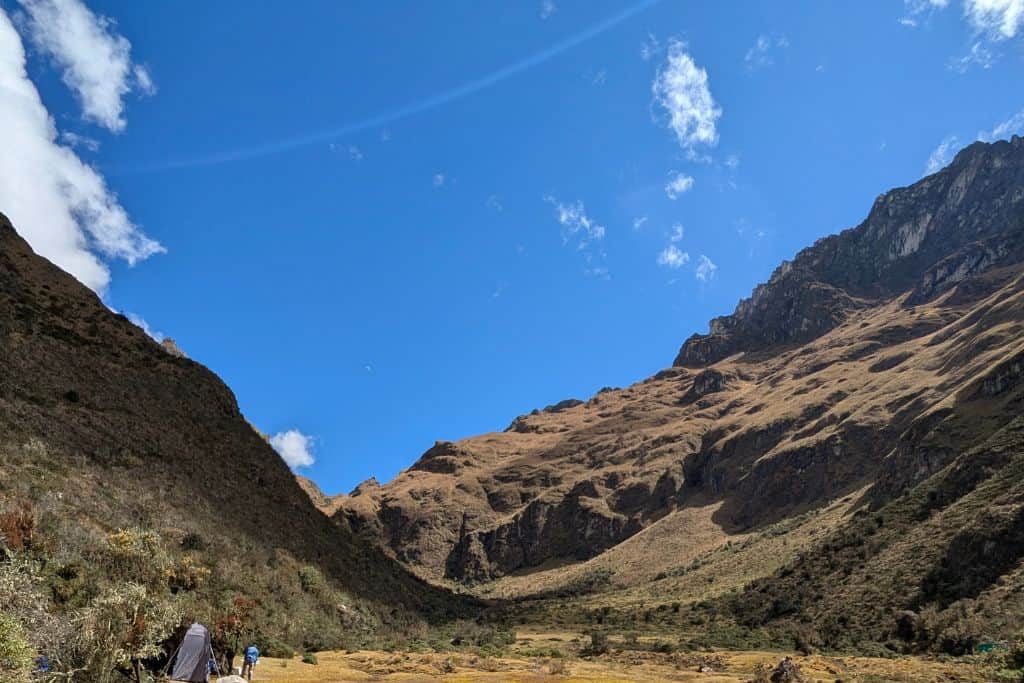
One lovely break spot was Llulluchapampa, a plateau about halfway up. We arrived at this meadow after a couple of tough hours and rewarded ourselves with a short rest. At Llulluchapampa (~3,800 m), we saw domesticated llamas grazing on the ichu grass. The treeline had long disappeared; around us were alpine grasses and wildflowers. The views were already spectacular – crystal-clear skies revealed snow-capped peaks behind us.
The last push to Dead Woman’s Pass was the hardest. The path became steeper and rockier, zigzagging up exposed switchbacks. With the altitude and exertion, my heart was pounding and legs felt like lead. Our guide taught us an Andean step-breathing rhythm to keep moving steadily. After about five hours of total climbing for the day, we finally saw the prayer flags and sign marking the summit of Abra Warmiwañusqa (Dead Woman’s Pass). We made it!
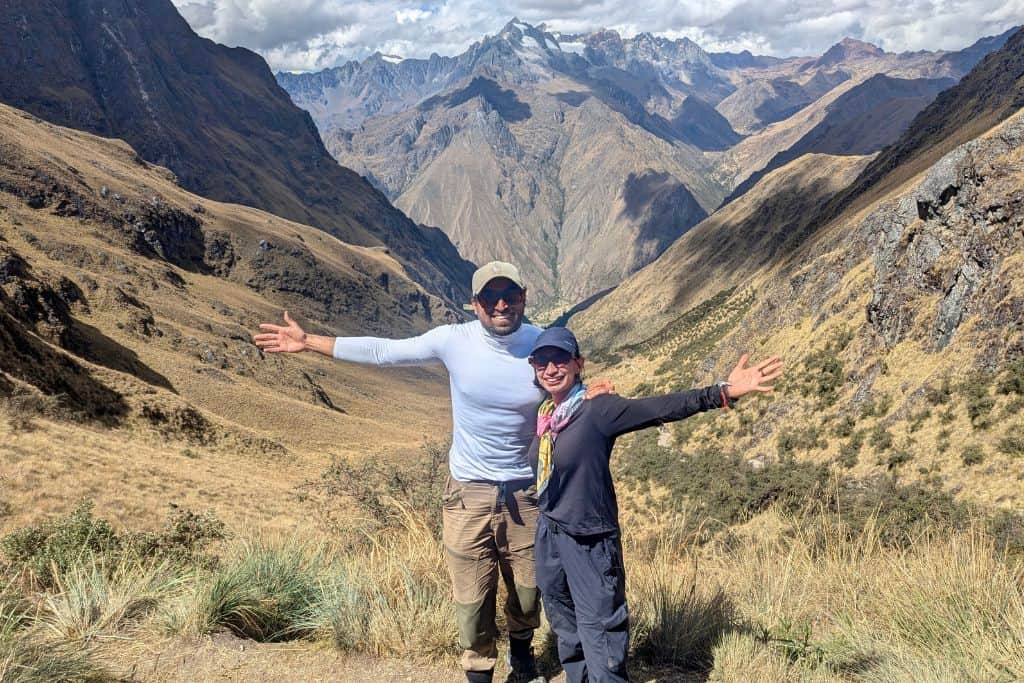
Reaching that pass felt absolutely triumphant. I stepped onto the top, overwhelmed with joy and relief. At 4,215 m (13,821 ft), we were on top of the world (or at least on top of this trail). The view was astonishing: jagged green mountains on either side and a deep valley ahead where the trail would lead us. It was a sunny day, and we were lucky to get a clear view of both sides of the valley.
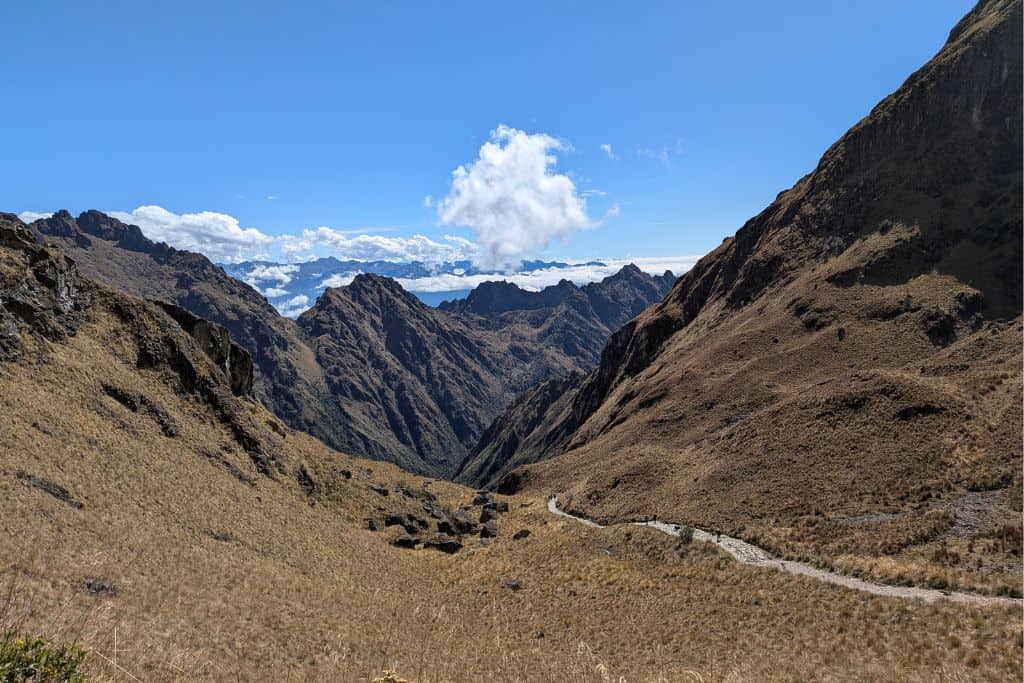
We didn’t linger too long in the thin cold air of the summit, just enough to catch our breath and take it all in. The descent awaited, and we knew we had a hot lunch waiting down in the valley. Going down from Dead Woman’s Pass was a relief for the lungs, but tough on the knees. The trail drops over 600 m on the other side via steep stone steps. I extended my trekking poles and was so grateful for them, they saved my knees from the brunt of each step. We moved carefully, as downhill can be slippery, especially with fatigued legs. The landscape here was an open alpine valley with sparse vegetation.
After about an hour or two of descent, we reached the valley floor known as Pacaymayo. Nestled by a small stream was our campsite for night 2, around 3,600 m altitude.
We stumbled into camp just in time for a late lunch, welcomed by applause from our porters (they always cheer as you arrive – talk about feeling like a rockstar!). Lunch was ready, and it might have been the most satisfying meal of my life simply because I was starving. We devoured bowls of quinoa soup and plates of chicken Milanesa with rice and vegetables. Our chef even surprised us with a homemade sauce that had a nice spicy kick; my appetite at altitude was in full force. After eating, we had the whole afternoon free to rest at Pacaymayo. Unlike the night before, we had arrived fairly early because of the short distance (though big elevation gain) we covered. I took advantage and crashed in my tent for a glorious mountain siesta.
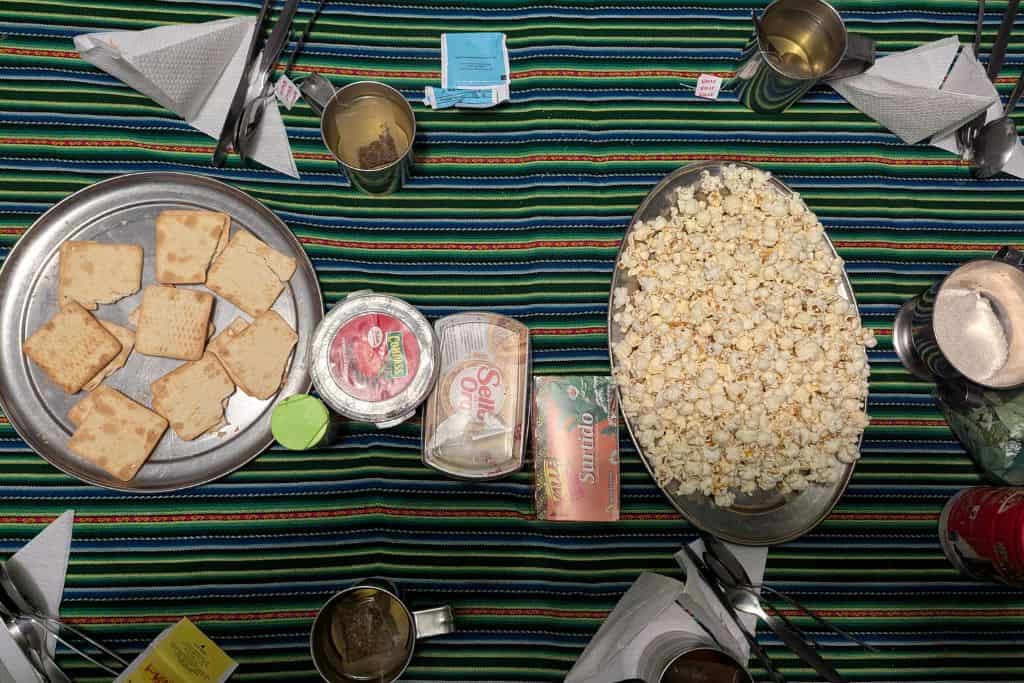
Pacaymayo camp sits in a valley between two big climbs, with a river cascading nearby. The sound of a waterfall echoed across the valley. The setting was beautiful in a raw, high-mountain way, though it was more crowded – this is a common campsite where 4-day and 5-day trekkers intersect. Compared to our quiet first night, we now saw a few other groups’ tents dotting the terraces. Still, by nightfall it was tranquil. The evening was chilly (dropping near freezing), so we layered up for dinner. The cook treated us to ají de gallina (a tasty Peruvian chicken stew) and even dessert – banana sauteed in pisco sour (yes, pisco our!) . As we ate, our guide congratulated us on conquering the hardest section of the trail. “It’s all easier from here!” he announced, which drew a big cheer.
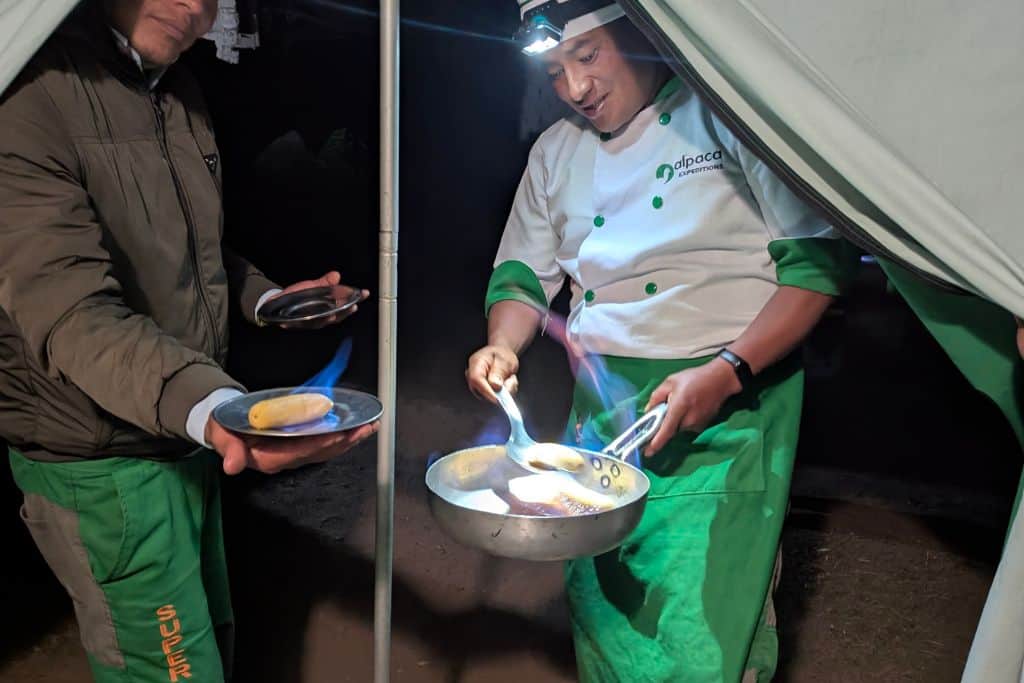
Before bed, I stepped outside and looked up. Even with a faint moon, the sky was dazzling – and being at 3,600 m, it felt like the stars were just an arm’s length away. I remembered a note I’d read: at high altitude, the night sky is exceptionally vivid, as if you’re closer to the cosmos. It was true. Despite the cold, I stood stargazing for a while, reflecting on the day.
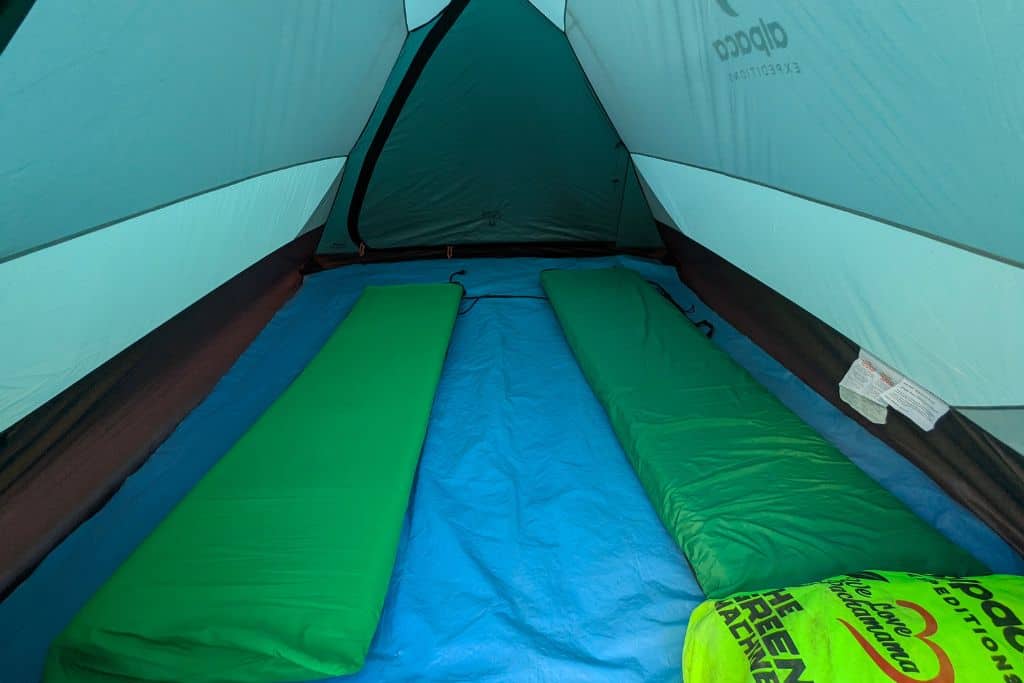
The hardest part was behind us, and it felt like a weight had lifted (literally, the weight of Dead Woman’s Pass!). We slept deeply that night, lungs acclimating, bodies tired but content.
Memorable Moment: Standing atop Dead Woman’s Pass, wind in my hair. I felt small, exhilarated, and profoundly alive, a moment of triumph I’ll never forget.
Day 3: Into the Cloud Forest – Ruins and the City Above the Clouds
Route: Pacaymayo – Runkurakay Pass – Sayacmarca – Chaquicocha – Phuyupatamarca camp
Terrain: Moderate ups and downs, two mountain passes (approx. 13 km); varied ecosystems from alpine to cloud forest
Meals: Breakfast in the valley; lunch by a scenic lake; dinner on a ridgeline (with a sunset view!)
I woke up on Day 3 feeling rejuvenated – no altitude headache, and muscles much less sore than expected. Maybe my body was finally adjusting, or maybe that cake had magical recovery powers! The porters brought our usual coca tea wake-up call at dawn. It had drizzled lightly overnight, and the morning was misty, giving the campsite a mystical atmosphere as clouds drifted through the valley. We knew this day would be a long haul (in fact, it turned out to be our longest day of hiking), but also the most scenic and diverse. Spoiler: Day 3 became my absolute favorite day of the trek.
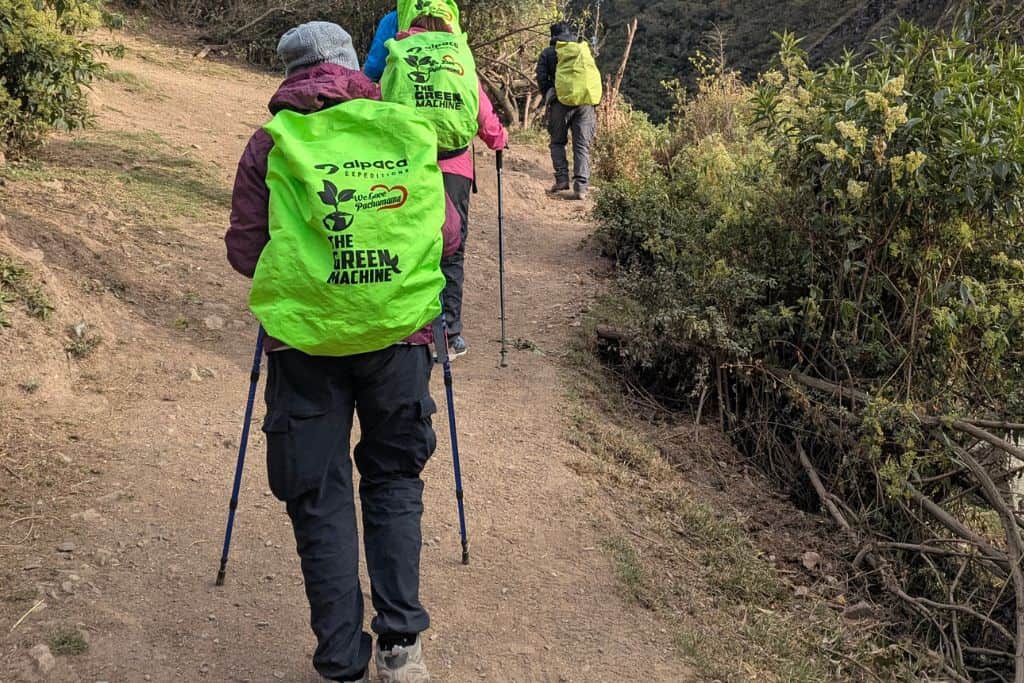
We set out after another substantial breakfast (the fried bacon and onion omelet they served was divine). Right out of camp, the trail led upward again – time to tackle the second major pass. The climb was initially steep but shorter than yesterday’s epic ascent. We paused at a small circular ruin called Runkurakay, an Inca watchtower perched on a cliffside overlooking Pacaymayo valley. This structure was impressive. Our guide explained it may have served as a rest stop or checkpoint for couriers on the royal road. I walked inside the ruin’s circular walls and imagined the messengers pausing here hundreds of years ago, lighting signal fires that could be seen down the valley.
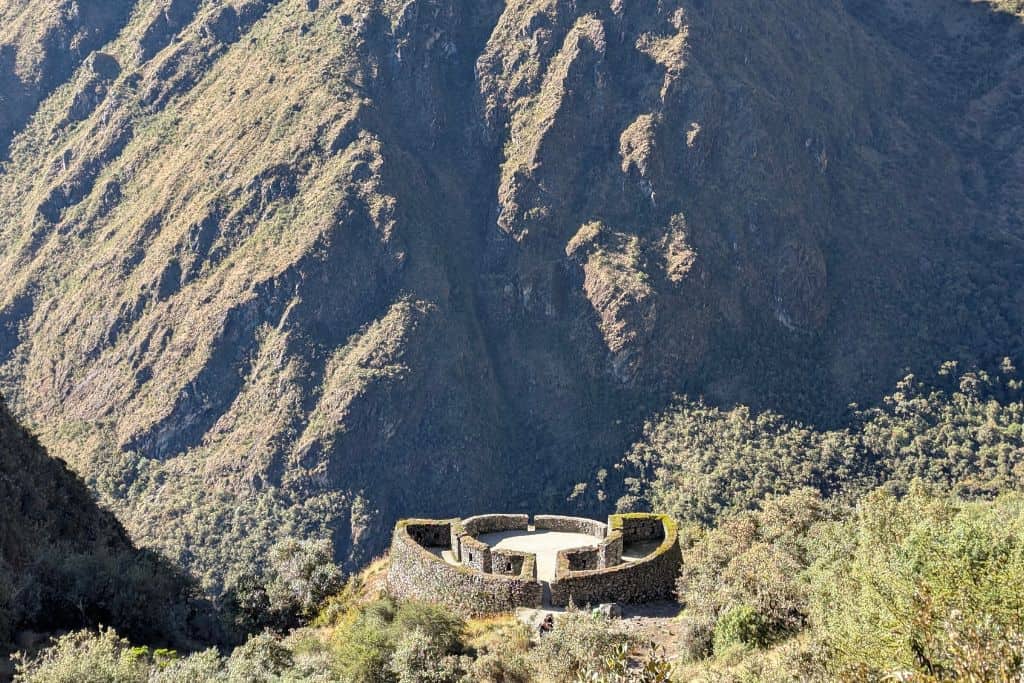
Continuing upward, we reached the top of Runkurakay Pass (~4,000 m). This pass was a bit lower than Dead Woman’s, and the approach gentler. The weather stayed sunny and beautiful. Suddenly, we were descending into lush cloud-forest terrain: mossy trees, fern groves, and even vividly colored orchids lining the trail. It felt like we’d entered a tropical fairyland. The stone path wound through the forest in a series of ups and downs.
Mid-morning, we arrived at Sayacmarca, one of the most stunning ruins on the Inca Trail. To reach Sayacmarca, we climbed a steep stone staircase and suddenly emerged onto terraces carved into a mountainside spur. The name means “Inaccessible Town,” and indeed it sits dramatically on a cliff with sheer drops on all sides. We explored the maze of stone rooms and narrow corridors – there were ritual fountains still flowing with water and vantage points that offered jaw-dropping views of the valley below. By now, the sun had broken through the clouds, illuminating the verdant hills. From Sayacmarca, we could even spot the silhouette of Mount Salkantay in the distance, its snow-capped peak gleaming (our guide pointed it out excitedly – Salkantay is one of the sacred Apus, or mountain gods, in the region, and seeing it is special). It’s no wonder some say Sayacmarca is one of the most beautiful ruins along the trail. Standing there, I felt a sense of connection to the past – how on earth did the Incas build a settlement in such a precarious location? The ingenuity of their engineering is mind-boggling.
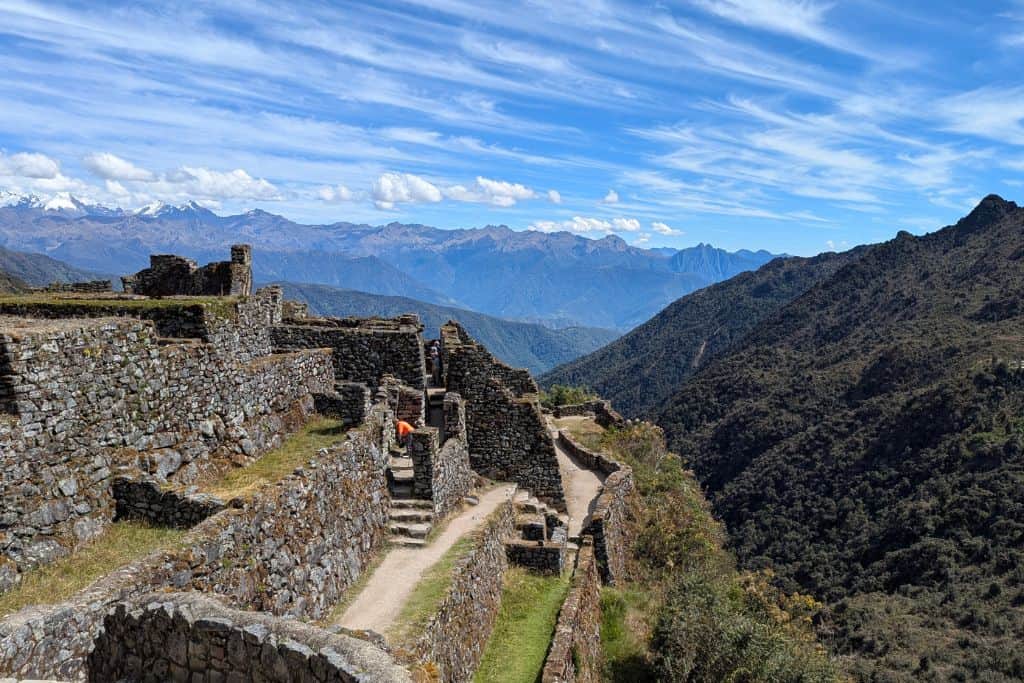
We reluctantly left Sayacmarca after a thorough guided tour and some time to wander on our own. The trail then led us through an enchanting section often called the “Inca flat” which, as our guide joked, means a gentle undulating path (not truly flat, but compared to passes, it felt easy). This portion was one of the prettiest walks: we traversed on a stone causeway through dense cloud forest, with butterflies fluttering around us and the calls of exotic birds echoing. Our guide pointed out some endemic plants, like the quenual tree with its peeling bark and delicate orchids clinging to branches. Every turn brought something new – at one point we went through a short Inca tunnel carved into the rock, at another we walked on a ridge with 360° views of green valleys.
We decided, as a group, to eat our lunch at the campsite. This meant we’d have to make do with just snacks during the hike, but the reward was well worth it. Having lunch at the site gave us more time to truly enjoy and settle into what turned out to be one of the best campsites we’ve ever stayed at – more on that later.
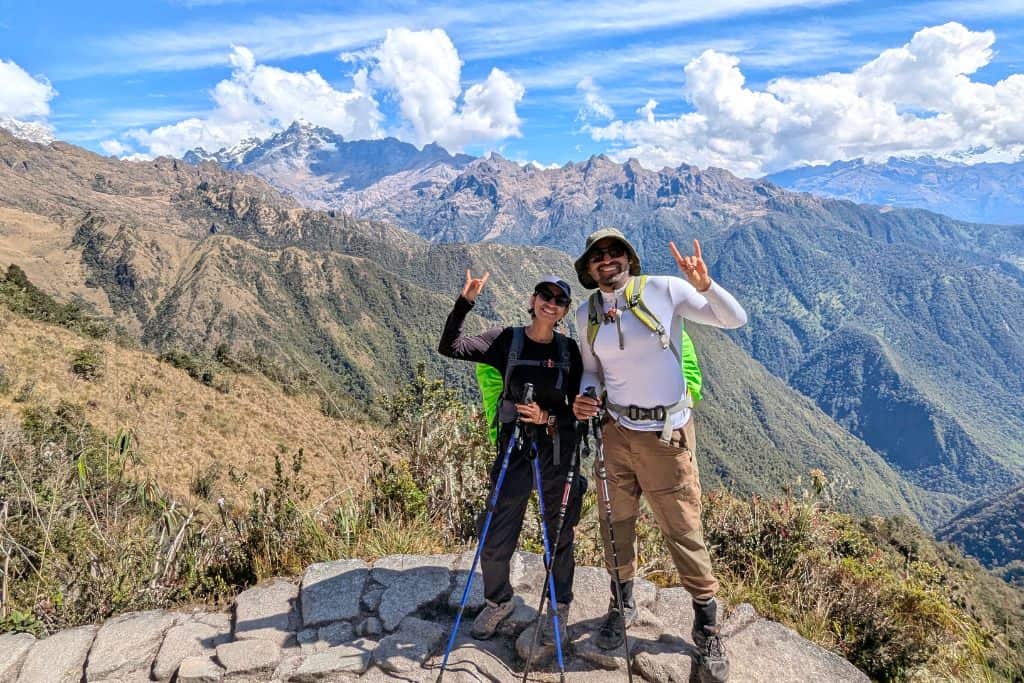
We decided to have our snack at Chaquicocha. After the quick snack, we continued onward for the last leg to our Day 3 campsite. The trail was relatively level (again, “Inca flat”) and arguably the most spectacular stretch of the whole trek. Beautifully engineered stone paving that contoured along the mountains. To our left, the terrain dropped off into deep valleys cloaked in cloud forest.
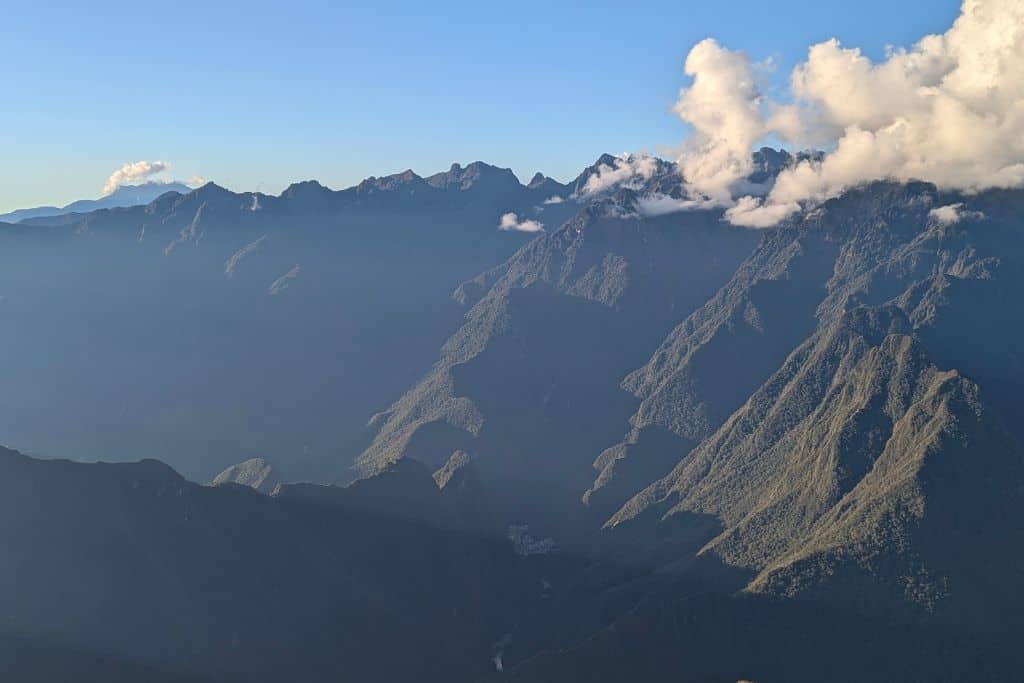
Later in the afternoon, as we ascended gently through woods of moss-draped trees, our guide announced we were close to camp. Suddenly, the forest opened up and we found ourselves on a high ridge. We had arrived at Phuyupatamarca, our campsite for Night 3. I literally gasped when I saw the view, it was phenomenal. Phuyupatamarca sits at about 3,680 m (12,073 ft) on a mountaintop, and its Quechua name fittingly means “town above the clouds.”. Puffy clouds were drifting through the valleys below us, and we could see a whole panorama of the Vilcabamba mountain range, including the snow-capped Salkantay. Even more thrilling, from a certain angle we caught our very first glimpse of Machu Picchu Mountain – the peak that looms behind the lost city. Though the Machu Picchu archaelogical site was out of sight, just knowing we were finally that close gave me chills.
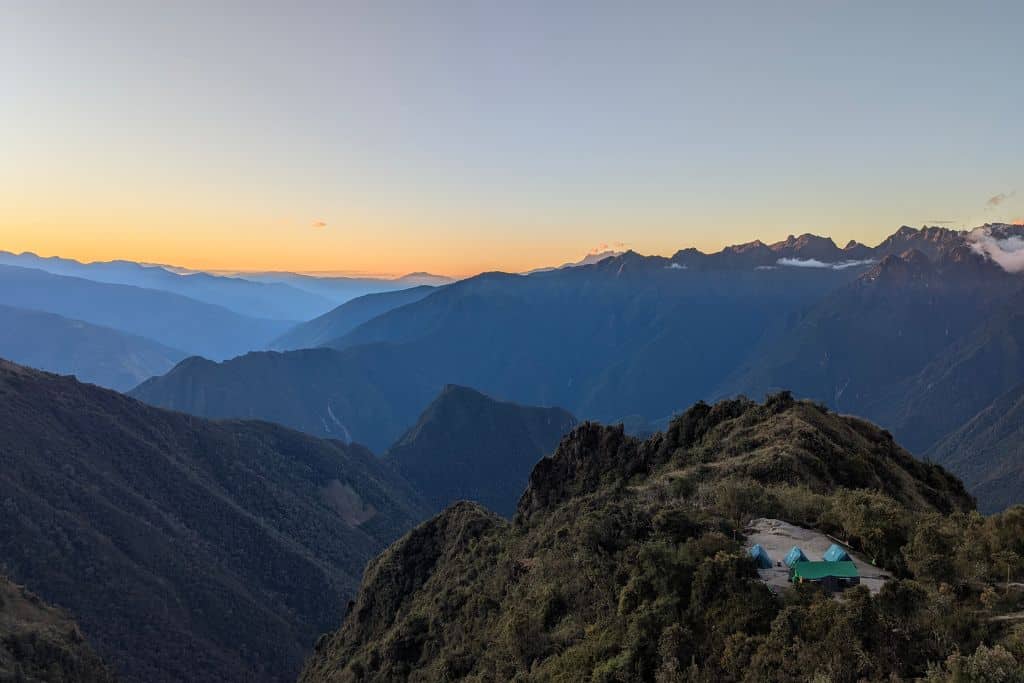
On today’s lunch menu: a delicious avocado salad, pumpkin soup, and stir-fried noodles with veggies and beef. At this point, our entire group was raving daily about the food – not only was it tasty, but we were burning so many calories that we devoured every bite and still had room for more. The chef even treated us to api, a warm purple corn drink, which tasted like a sweet berry tea – a local specialty I’d never had before.
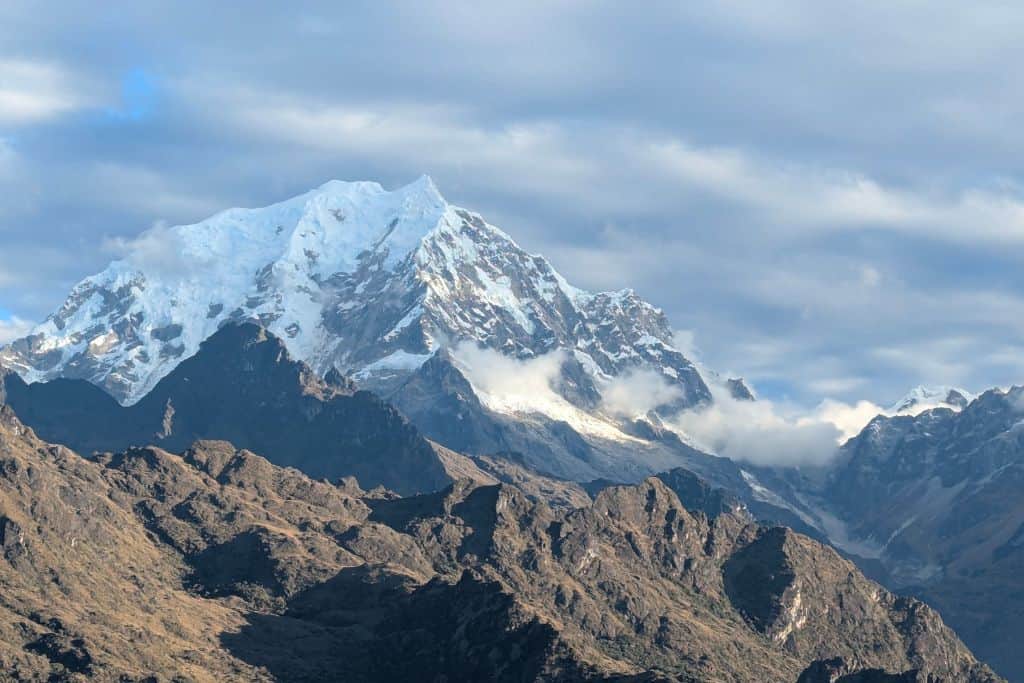
Our campsite was literally adjacent to the Phuyupatamarca ruins – an Inca ceremonial site with cascading stone terraces and six intricately built ritual baths fed by spring water. Before dinner, we had time to wander through this site as the sun was going down. I walked carefully down the Inca steps into the ruins. We sat on one of the terraces in silence for a few minutes, just absorbing the atmosphere – the clouds shifting to reveal peaks and then swallowing them again.
The porters called us for tea time, and in the dining tent enjoying hot coffee and popcorn, chatting about the incredible day we had. One of our friends remarked, “This day alone was worth the whole trip.” I had to agree, we’d seen so many distinct environments (alpine tundra, cloud forest, subtropical jungle) and awe-inspiring ruins all in one day.
Suddenly, someone exclaimed, “Go outside, you have to see this!” We rushed out of the tent to witness one of the most beautiful sunsets I’ve ever seen. The clouds had cleared just enough on the western horizon for the sun to peek through. The sky blazed in hues of orange, pink, and purple. In the distance the snowy cap of Mt. Salkantay glowed in the setting sun’s rays, and below us a sea of clouds turned pastel shades. We could even make out the sinuous line of the Urubamba River far below, reflecting the colors of the sky. It was pure magic. Our whole group stood there on the mountaintop, speechless, as the sun dipped behind the peaks. Moments like that feel almost transcendental. I remember feeling a profound gratitude for being exactly where I was, right then.
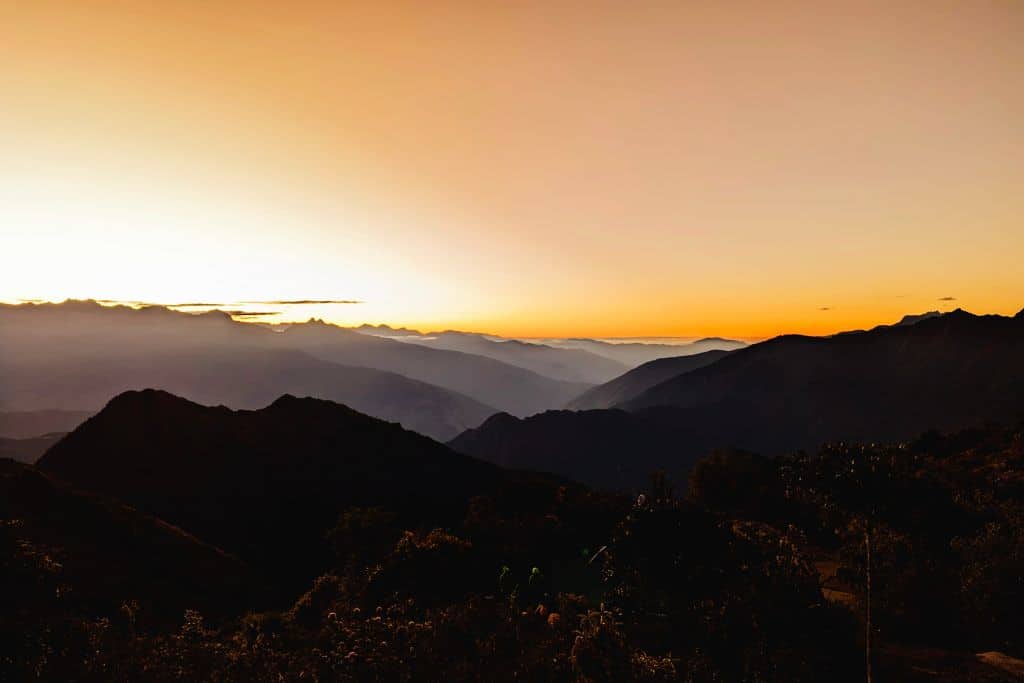
That evening, dinner was amazing. We knew it was our last dinner on the trail with the porters and cook (tomorrow at lunch we’d bid them goodbye), so the mood was celebratory and a bit bittersweet. The chef pulled off yet another amazing meal – I particularly loved the fresh trout in garlic sauce he prepared, which tasted heavenly at 12,000 feet. After dinner, most of us stayed up a little longer than usual, reluctant to end the day. The sky was crystal clear now, and oh my goodness, we truly were in the “town above the clouds.” There was a carpet of clouds below reflecting the moonlight, and above, an explosion of stars. I spotted several shooting stars within minutes. In the distance we could see tiny lights, that was the town of Aguas Calientes far below, a reminder that civilization (and Machu Picchu) was near. It was chilly, probably just a few degrees above freezing, but I barely noticed the cold. A couple of us sat outside in our jackets just to gaze at the Milky Way.
Crawling into my tent, I felt a twinge of sadness that the camping portion of our trek was almost over. We’d gotten into a rhythm of trail life that I absolutely loved: early mornings, walking through epic landscapes, learning history, bonding with fellow hikers over meals, and falling asleep to nature’s sounds. But excitement was building too – tomorrow we would finally reach Machu Picchu! With that thought, I drifted into one of the deepest sleeps of the trip, enveloped by the silence of Phuyupatamarca.
Memorable Moment: Watching the sunset from Phuyupatamarca camp, well above the clouds. The sky turned fiery orange behind Salkantay’s silhouette, and for a moment time stood still. It felt like the spirits of the Andes were all around us, an almost spiritual end to an incredible day.
Day 4: Phuyupatamarca to the Sun Gate and Machu Picchu
Route: Phuyupatamarca – Intipata – Wiñay Wayna – Inti Punku (Sun Gate) – Machu Picchu
Terrain: Predominantly downhill (approx. 12 km). Expect about 1,200 m of total descent.
Meals: Breakfast at Phuyupatamarca, lunch at Wiñay Wayna, dinner in Aguas Calientes
We woke up early that day to witness one of the most spectacular sunrises of our trek. As golden light spilled over the mountains with hot coca teas in our hand, we felt immense gratitude.
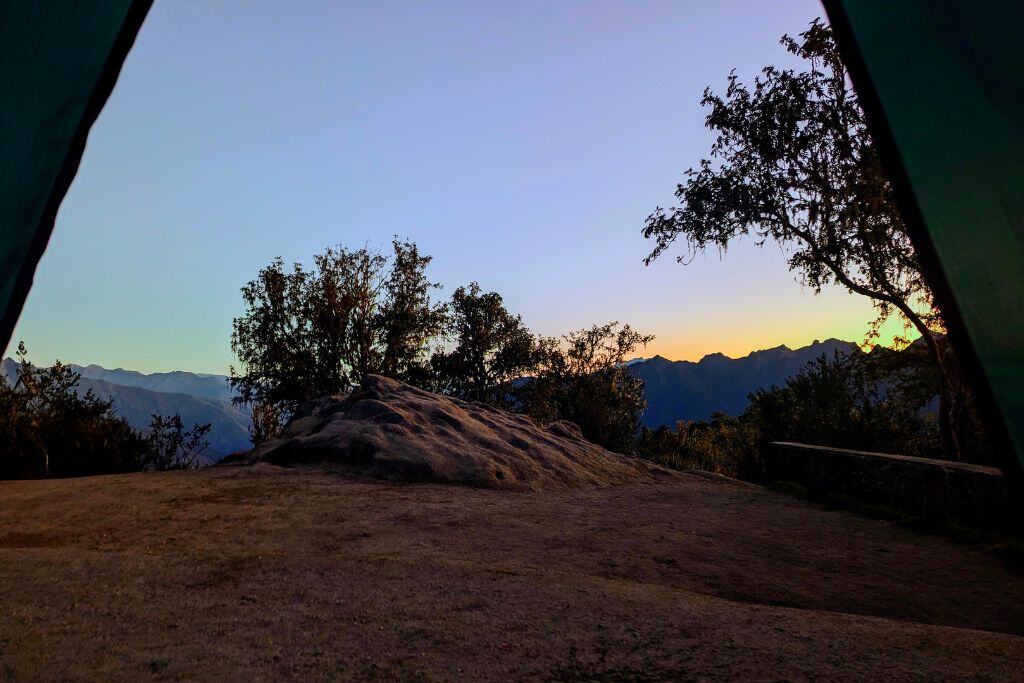
After breakfast, our guide led us on a short tour of Phuyupatamarca’s ruins. Our guide explained that Phuyupatamarca likely served as a religious and rest spot for pilgrims on their way to Machu Picchu, and its baths might have been used for ceremonial purification. It truly felt spiritual there.
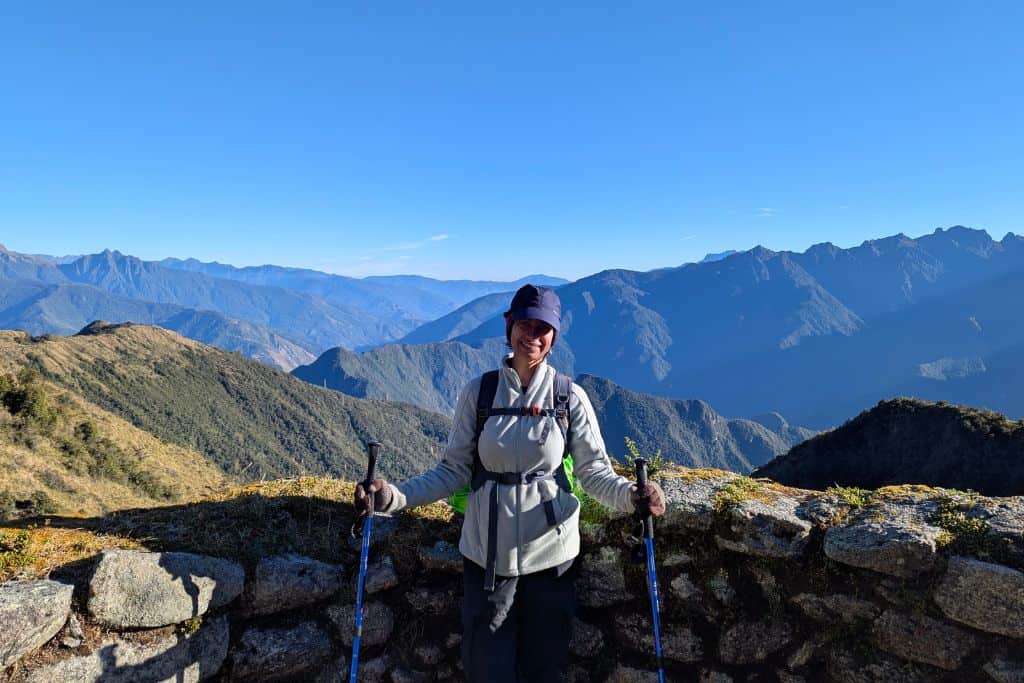
My knees were thankful for hiking poles on this endless staircase, which reportedly has thousands of steps. We took our time, savoring the changing scenery: hummingbirds darted among flowering shrubs, and occasionally the trees opened up to jaw-dropping views of the valley far below.
As we neared the bottom of this descent a couple hours later, the ruins of Intipata came into view. Intipata (meaning “Terraces of the Sun”) is a set of dramatic agricultural terraces built into a steep mountainside. The site truly looks like a giant staircase of green steps. We left the main trail briefly to walk out onto Intipata’s wide terraces.
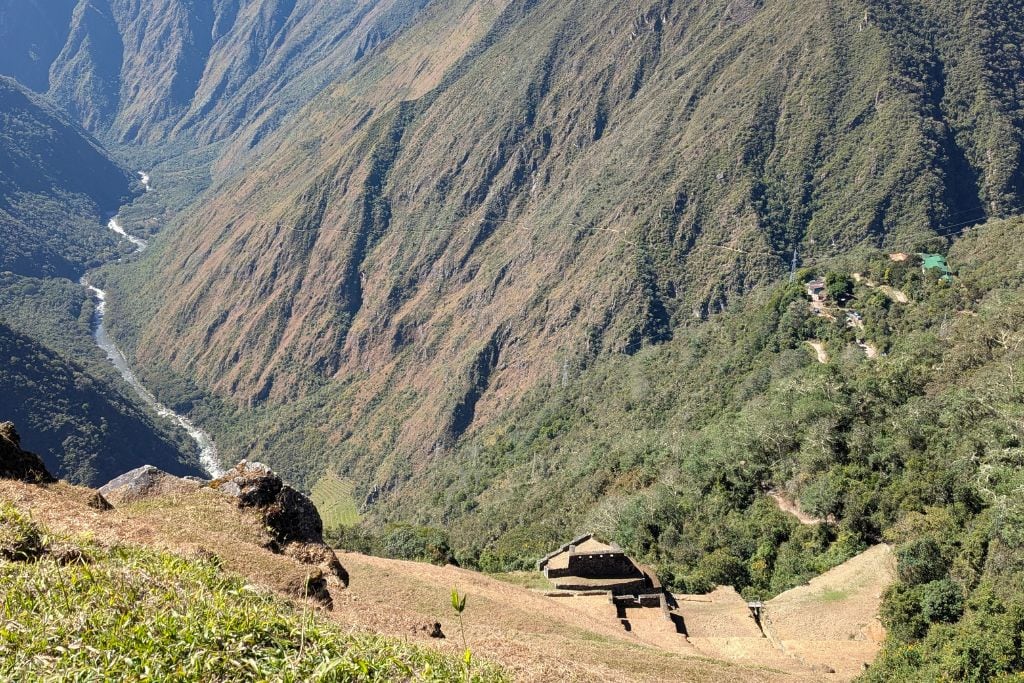
Standing there, we had sweeping views of the Sacred Valley opening up below – a patchwork of jungle and river framed by Andean peaks. The sun was climbing higher now, illuminating the perfectly curved rows of stone terraces. Our guide explained that Intipata was likely used to grow crops for Machu Picchu, and we could still spot old irrigation canals threading through the terrace levels. It felt like a hidden gem indeed – quiet, with no other trekkers around.
From Intipata it was a short hike further downhill to Wiñay Wayna, the last major ruin before Machu Picchu. We arrived at Wiñay Wayna (meaning “Forever Young”) in the late morning, and I was immediately struck by how large and breathtaking this site was. Wiñay Wayna is the most extensive Inca complex on the trail besides Machu Picchu itself. Dozens of curved terraces hugged the slope, and above them stood remains of temples and houses connected by stone stairways. We took time to explore Wiñay Wayna’s ruins.
Climbing a narrow stone staircase, we found a series of upper rooms and water fountains that might have been ritual baths. It’s easy to see why archaeologists think Wiñay Wayna served as a farming and administrative center supporting Machu Picchu. My legs were trembling a bit from the long descent, but my heart was full. This was our last ruin before Machu Picchu.
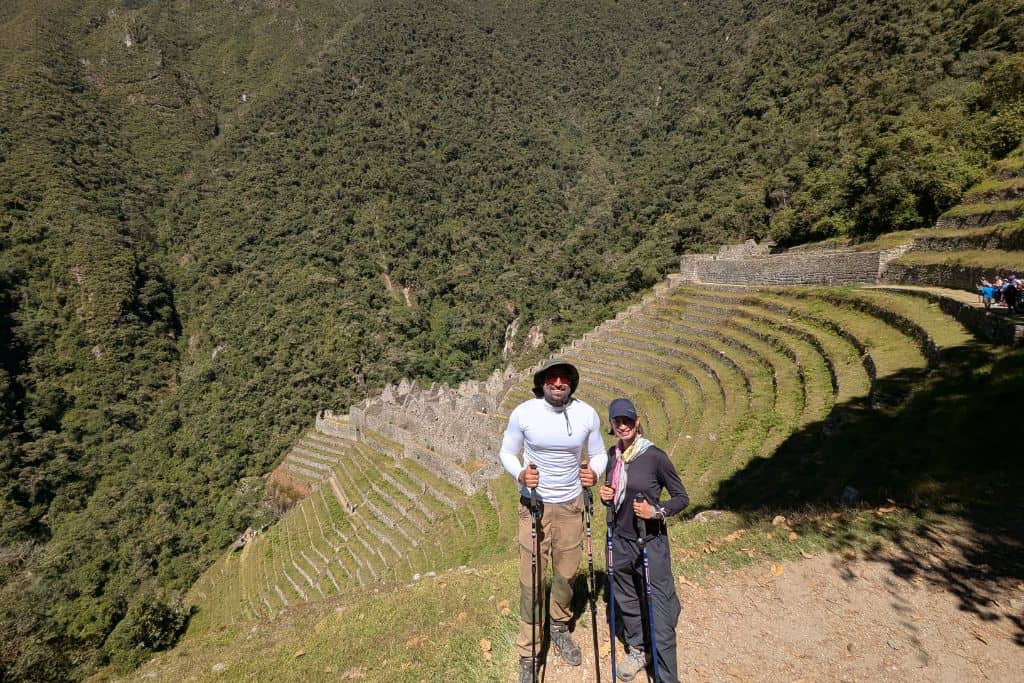
Just a short walk from the ruins was the Wiñay Wayna campsite, where a hot lunch awaited – our final meal prepared by the trek cooks. By now it was early afternoon and we were ravenous. The chefs did not disappoint: we feasted on a savory quinoa stir-fry, vegetable soup, and even a freshly baked cake congratulating us on making it this far! It was incredible what they could whip up on a portable kitchen at 2,650 m elevation.
The bittersweet part was knowing this was our last meal with the porters and cook team. After lunch, our guide organized the traditional thank-you ceremony for the porters. We gathered in a circle, and each of us individually thanked these hardworking men who had carried tents, food, and our duffels over mountains for four days. We cheered and clapped for “los porteros,” and some of them shyly smiled or said a few words in Quechua, which our guide translated.
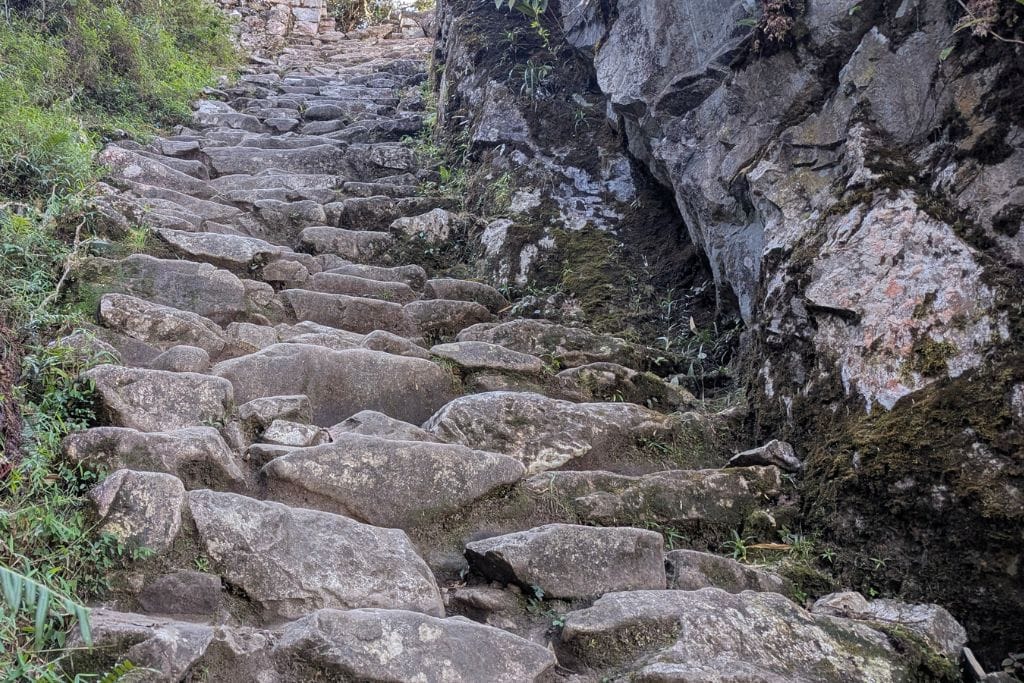
The trail was quieter now; most 4-day trekkers had already passed through in the early morning, so we had this afternoon trek almost to ourselves. Despite our fatigue, an almost giddy energy took over – we were so close to our goal that every step felt lighter. As we approached Inti Punku, the trail ascended a final set of infamous steep steps nicknamed the “Gringo Killer.” We scrambled up using our hands for balance – a fun little challenge – and suddenly there we were: standing at the Sun Gate (Inti Punku), gateway to Machu Picchu. We had made it!
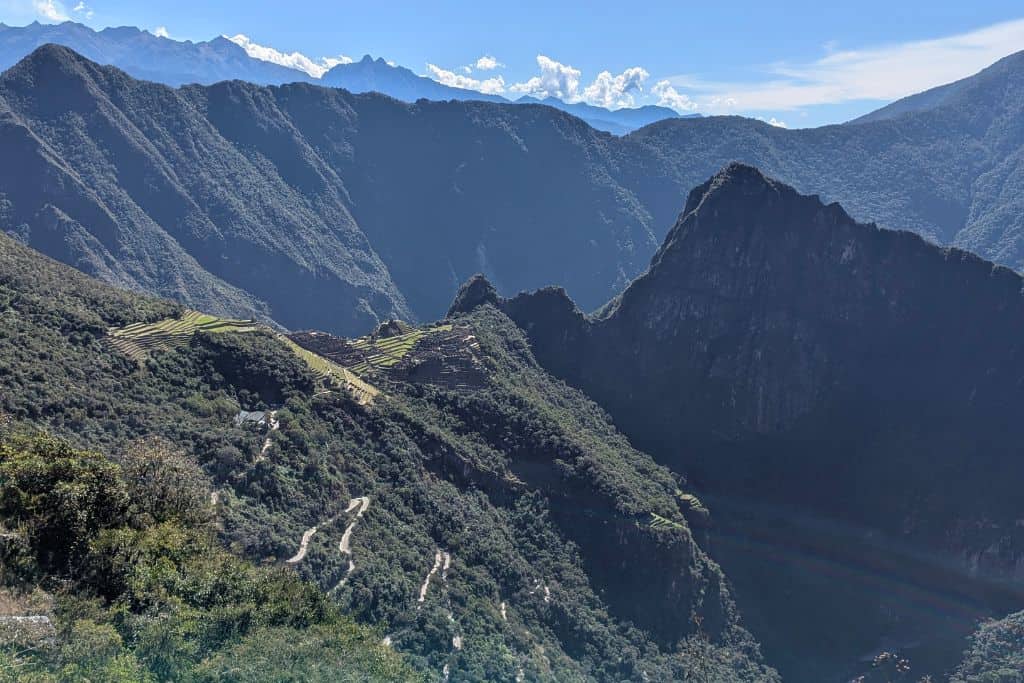
As we looked down from the Sun Gate at Machu Picchu far below, finally in view. I will never forget that moment. Machu Picchu appeared smaller than I expected from this distance, but absolutely magical. After four days of challenging trekking – up killer passes, through rain and shine, sleeping on the ground – here was the reward: Machu Picchu basking in golden-hour light, and we had it almost all to ourselves.
Inti Punku itself is a small stone structure (more of a doorway or threshold) that in Inca times served as a checkpoint and ceremonial gateway for pilgrims entering Machu Picchu. Standing there, I truly felt like a pilgrim who had earned my entrance.
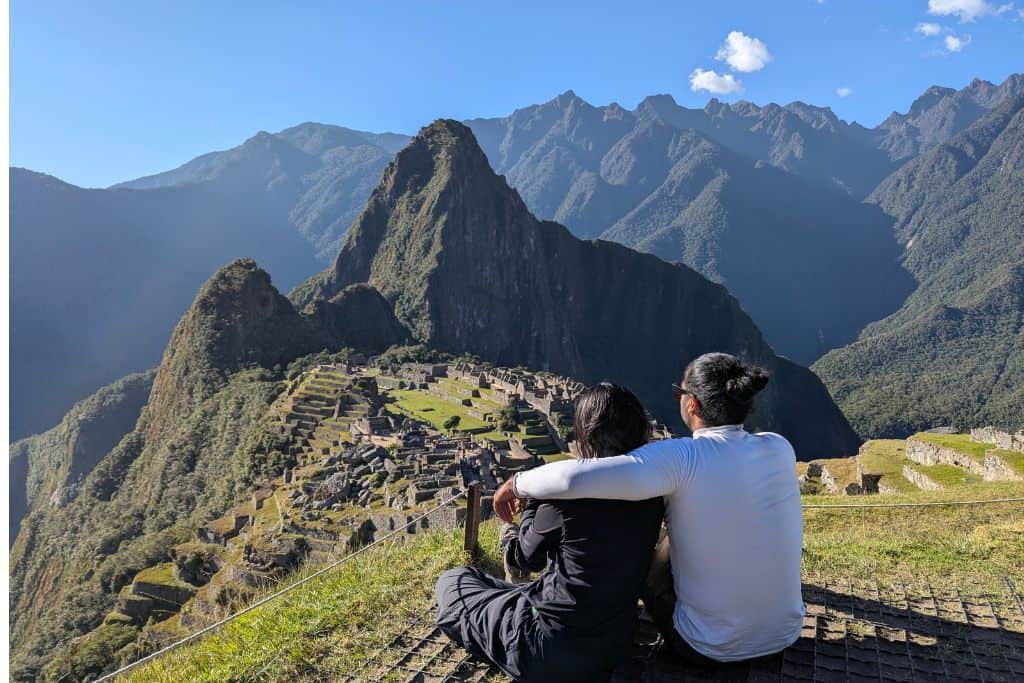
We began the descent from the Sun Gate to Machu Picchu, a walk of about 45–60 minutes down stone steps. The trail here was gentle and filled us with anticipation rather than fatigue. As we got closer, Machu Picchu’s details emerged – we could see the stone walls and terraces more clearly. Finally, we stepped through the official entrance checkpoint of Machu Picchu (exiting the trail) just as the late-afternoon sun was about to disappear. We had arrived at Machu Picchu!
We walked to an open terrace viewpoint (near the Guardian’s Hut) and took in Machu Picchu up close. Machu Picchu was no longer a postcard or a dream; it was real and right in front of me, and I had walked every step of the way here. We had some time to soak in the view – first we took some photos, and then spent the next 30 minutes admiring the miracle that is Machu Picchu.
As dusk settled, it was time to head down to Aguas Calientes for the night. We exited the site and boarded a shuttle bus just outside the gates. The bus ride down was about 20 minutes – the road (called the Hiram Bingham highway) zigzagged down the steep mountain face we had just seen from above). We arrived in Aguas Calientes (also known as Machu Picchu Pueblo) just after nightfall. The little town’s streets were bustling with trekkers, tourists, and locals, all under the glow of street lamps. Checking into our hotel (a simple but comfortable inn provided by Alpaca Expeditions) felt almost luxurious after three nights of camping. A hot shower never felt so good – I could practically see layers of trail dust swirling down the drain!
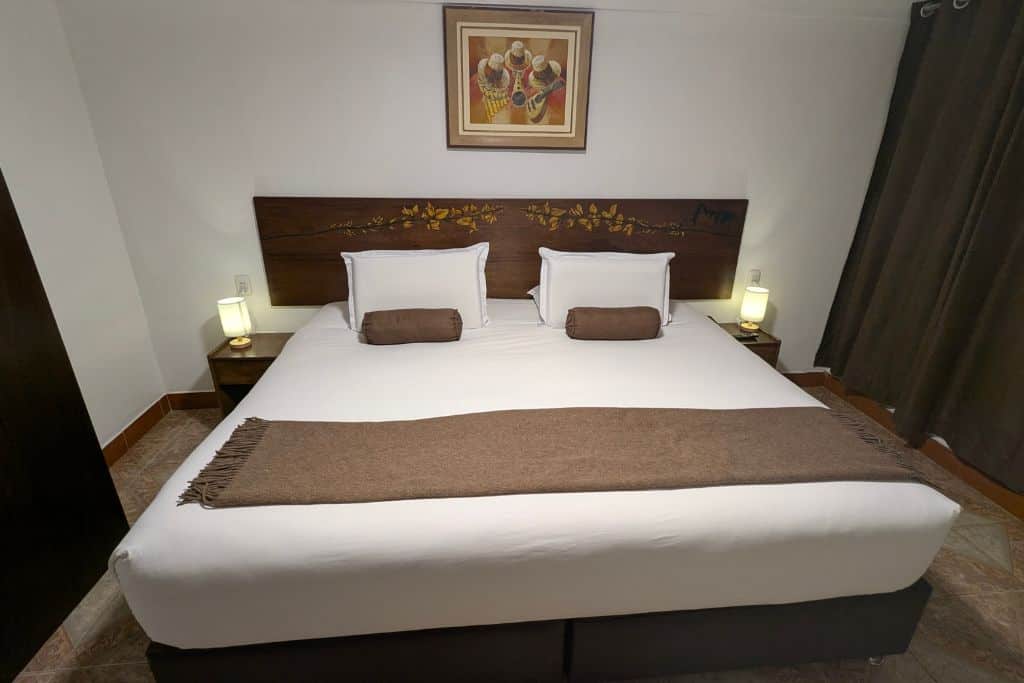
There was a sense of celebration in the air, but also a hint of sadness knowing our adventure was nearly over. That night I slept in a real bed with a real roof over my head, yet strangely I missed the sounds of nature from our campsites. Tomorrow, Machu Picchu awaited us one more time.
Memorable moment: From the Sun Gate, when we got our first breathtaking glimpse of Machu Picchu far below, framed by green peaks.
Day 5: Sunrise at Machu Picchu – A Dream Fulfilled and the Journey’s End
Day 5 was not a trekking day per se, but an exciting day of exploration and travel. We woke before dawn at our Aguas Calientes hotel, had a quick breakfast, and then caught the shuttle at 6 am to Machu Picchu (the buses start running at 5:30 am).
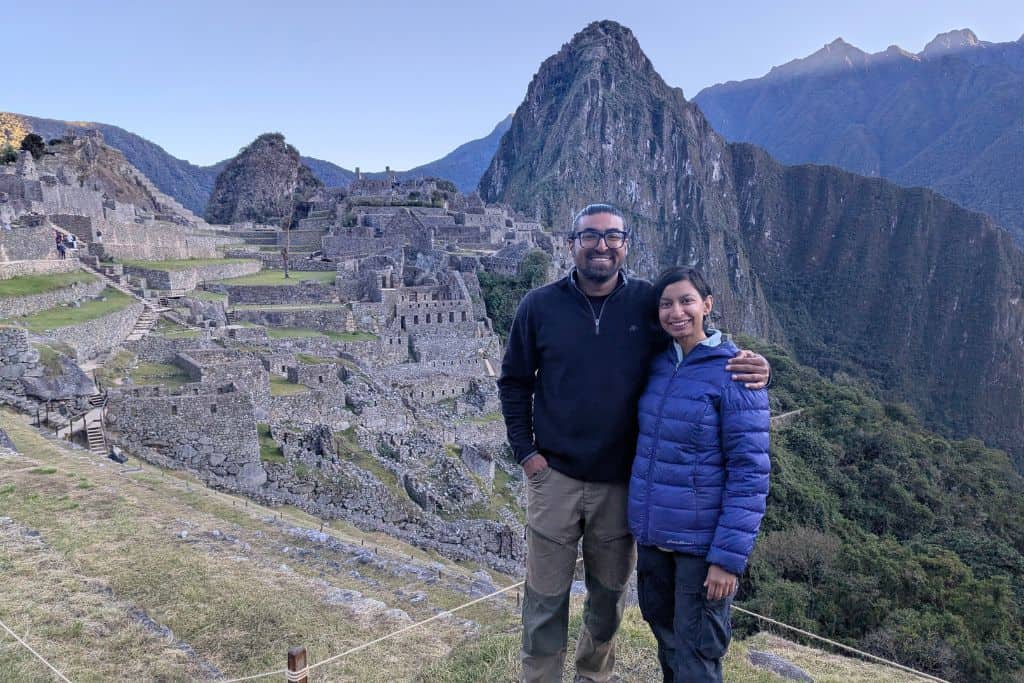
Upon arrival, we entered the sanctuary early, just as the sky was brightening. The guided tour of Machu Picchu covered the major sectors of the citadel over ~3.5 hours, from the Temple of the Sun to the Intihuatana stone and the urban and agricultural zones. We wandered the stone paths and terraces that zigzag across the site, marveling at the precise Inca stonework and the sheer scale of the ruins. There was only minimal “hiking” this day – perhaps 3 km of walking around Machu Picchu’s grounds and up and down steps during the tour – so our legs got a well-earned rest.
After the tour, we had some free time to take photos and absorb the atmosphere. (Those who had pre-booked permits for extra hikes, like the steep climb up Huayna Picchu, broke off at this time – but our group opted not to.) By late morning we regrouped and exited Machu Picchu, then rode the bus back down to Aguas Calientes.
In the early afternoon we said farewell to Machu Picchu and boarded the train (pre-booked for us by Alpaca Expeditions) for our journey back to Cusco. The train carried us through the Urubamba Valley, retracing in 1.5 hours what had taken us five days on foot. We transferred to a private bus in Ollantaytambo and completed the last leg to Cusco by evening, where the trek officially ended (hotel drop-off around 7–8 pm).
Memorable Moment: Standing at the Guardian’s Hut viewpoint, we watched as the first rays of sun peeked over the Andes, illuminating Huayna Picchu and then spilling down onto the stone ruins below.
Complete Packing List: Check out our complete packing list for the Inca Trail HERE
4D/3N vs 5D/4N: Classic vs Extended Inca Trail
One big question prospective trekkers face is: should I do the classic 4-day Inca Trail or opt for a 5-day/4-night version? Having experienced the 5D/4N, I can share some insights on how it differs from the standard route. Both treks cover the same iconic 43 km of Inca Trail to Machu Picchu, but the pacing and experience can feel quite different. Here’s a breakdown of key differences and what you gain (or miss) with the extra day:
Pace and Acclimatization
The 5-day trek is more relaxed in pace, which was a huge benefit for us. This made the climb a bit more manageable. Daily hiking distances on the 5D were slightly shorter, meaning we arrived at camps earlier and weren’t as rushed. We had time for side hikes, photo breaks, or just to catch our breath.
In contrast, the 4D itinerary crams some long, tough days back-to-back. If you’re worried about fitness or altitude, the 5D trek provides a buffer that can make the journey more enjoyable (though it’s still no walk in the park – the trail is challenging regardless!).
Campsites and Crowds
A big advantage of the 5D/4N is access to better, less crowded campsites. Because 5-day groups are on a different schedule from the majority, you often stay at camps that see fewer people. For example, as I gushed about above, we camped at Phuyupatamarca on Night 3, which was spacious, quiet, and stunning. 4-day treks typically bypass that and stay at Wiñay Wayna, which can have dozens of tents crammed together.
In short, the 5-day gave us a more intimate, wilderness-like experience – there were moments we felt like we had the Andes to ourselves.
Time to Explore & Enjoy
With an extra day, we had more time to explore the Inca ruins and nature along the trail. Our guide took us on unhurried tours of sites like Llactapata, Sayacmarca, and Wiñay Wayna. We could linger, ask questions, even meditate a bit at these spiritual spots.
Essentially, the 5D/4N gave us breathing room to savor the journey, not just the destination.
Machu Picchu Arrival
Both treks ultimately get you to Machu Picchu, but the timing differs. The 4-day trek famously wakes you at 3:30–4:00 a.m. on the last day to race from Wiñay Wayna to the Sun Gate at daybreak. It’s exciting, but it also means walking in the dark pre-dawn, often in a traffic jam of trekkers on the narrow path, all aiming for that sunrise view. Many find it a bit anticlimactic, since you arrive in a crowd and you’re exhausted from the early wake-up.
On our 5-day trek, we approached the Sun Gate (Inti Punku) in the late afternoon of Day 4, when it was virtually empty. We had that iconic first glimpse of Machu Picchu bathed in late-day sunlight, and it was breathtaking and peaceful – we sat there for nearly an hour almost alone, soaking in the scene. Because we weren’t in a rush, it felt more meaningful, a moment to truly let it sink in that we’d walked all this way to behold this view.
Afterward, instead of immediately starting a guided tour while dead-tired, we took a side trail down and caught a bus to Aguas Calientes for a hotel night. The next morning (Day 5), we returned refreshed for our Machu Picchu tour at sunrise. I can’t overstate how nice it was to shower and sleep in a real bed before touring Machu Picchu – we had energy and focus to fully appreciate the lost city. Many 4-day hikers tour Machu Picchu right after that pre-dawn hike, running on fumes because they’d been up since 3 a.m.
Who Might Prefer 4D
Of course, the 4-day trek has its merits too. It’s the classic route taken by thousands, and if you’re short on time or budget, it gets you to Machu Picchu one day quicker (and usually a bit cheaper).
Also, if you’re very fit or experienced and don’t feel the need for a slower pace, 4-day can be perfectly enjoyable. You won’t miss any major ruins or scenery; everything is still there, just compressed. And many people do fine with it, especially if well-acclimatized and prepared to wake up early and possibly deal with crowds at the final campsite.
Final Thoughts
Standing in the Machu Picchu citadel on the final day, gazing at the sun-kissed stone temples with the trail dust still on my boots, I felt an overwhelming sense of accomplishment and wonder. The 5-day Inca Trail trek wasn’t just a hike – it was a journey through history, a test of endurance, and a feast for the senses. Over those days, I walked on ancient footsteps, touched the stones carved by a long-gone civilization, and experienced the raw beauty of the Andes in a way that will stay with me forever.
Would I recommend the 5D/4N version of the Inca Trail? Absolutely, yes. If you cherish the idea of not rushing and want to fully immerse yourself in the experience, the 5-day delivers. It gave us the chance to see rarer angles of the trek – like that sunrise at Phuyupatamarca and an unrushed first view of Machu Picchu without a crowd.
Our guides from Alpaca Expeditions were superb – passionate about their culture, attentive to everyone’s pace and needs, and often going above and beyond (like surprising us with that cake and endless encouragement). The porters, the true MVPs, carried heavy loads yet always greeted us with smiles and cheer. Knowing we were with a company that treats their staff well and invests in local communities made it all the more meaningful.
This post includes affiliate links, which means that if you make a purchase or booking through them, we may receive a small commission. It doesn’t cost you anything extra, but it helps us keep the blog going. We truly appreciate your support!
Read More About Peru
READY TO TRAVEL LIKE A LOCAL?
Book a free 30-minute consulting call with us and let’s start planning your next unforgettable adventure!

